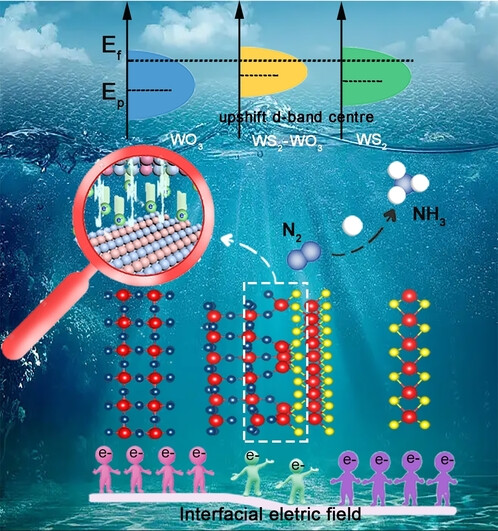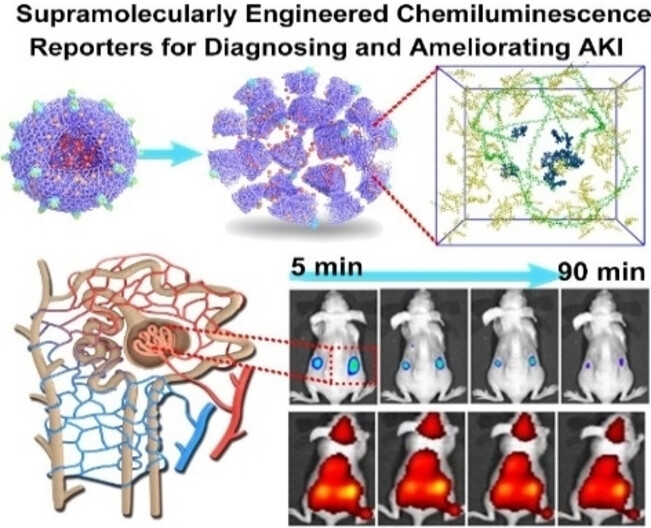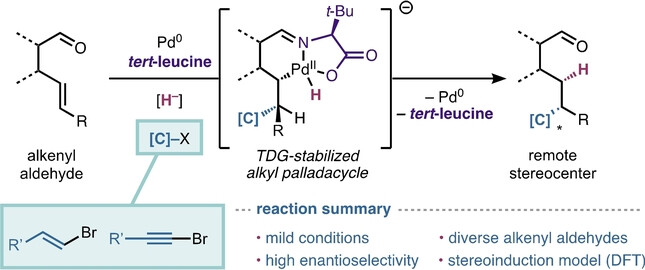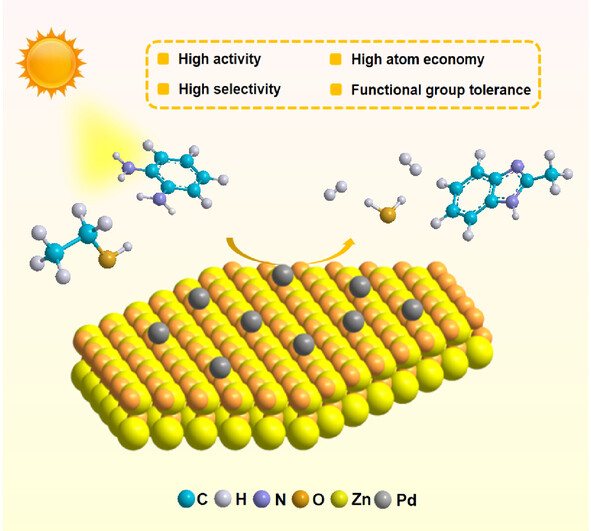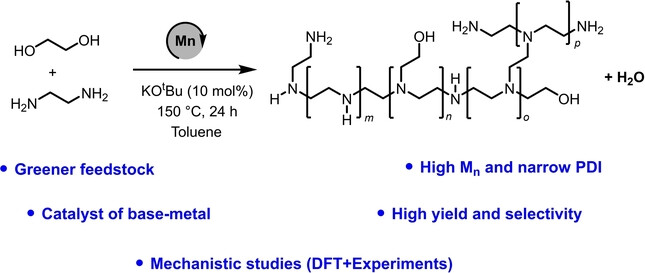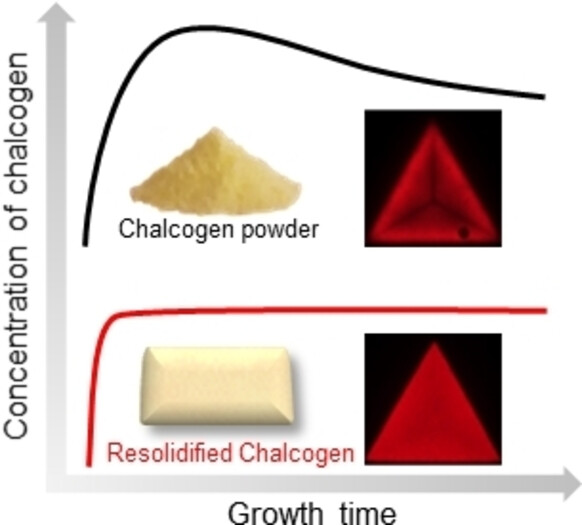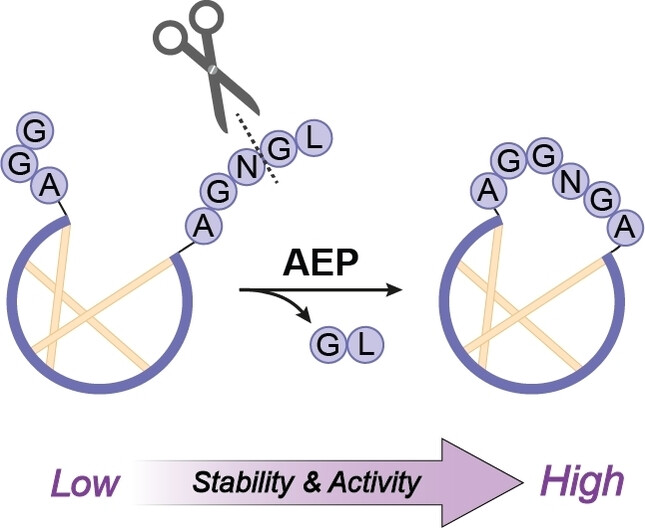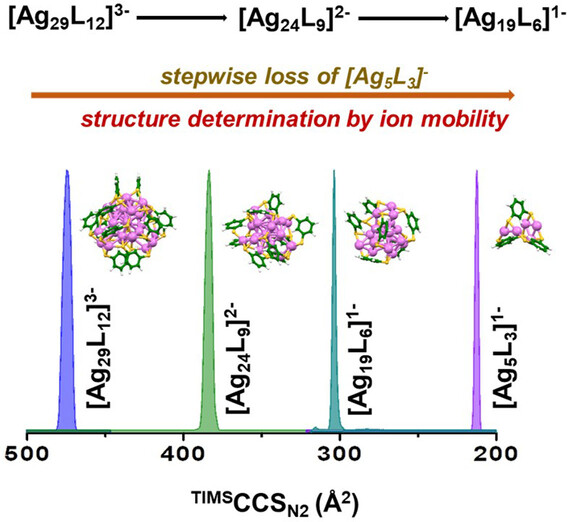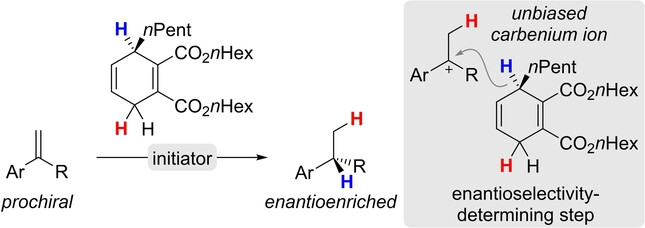Journal list menu
Export Citations
Download PDFs
Cover Pictures
Cover Picture: Cyclotetrabenzil Derivatives for Electrochemical Lithium-Ion Storage (Angew. Chem. Int. Ed. 29/2023)
- First Published: 22 June 2023
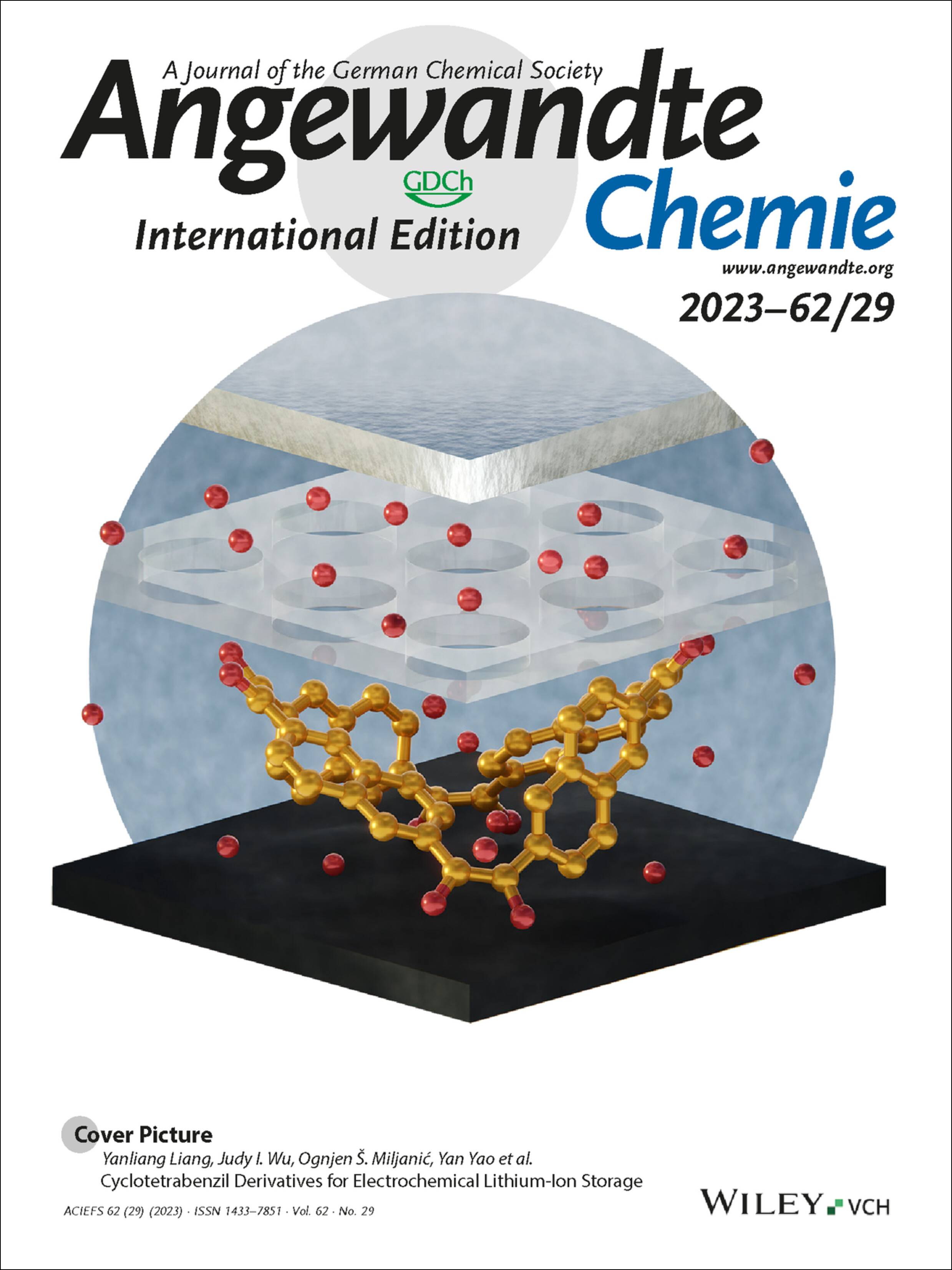
Organic electrode materials could break the dependency of lithium-ion batteries on minerals that are scarce and mined in conflict zones. In their Communication (e202300892), Yanliang Liang, Judy I. Wu, Ognjen Š. Miljanić, Yan Yao et al. report a naphthalene-based cyclotetrabenzil macrocycle as a promising organic electrode candidate. Its eight redox-active groups bring about a high specific capacity of 279 mAh g−1, while the low solubility—a consequence of the shape-persistent structure—results in stable cycling performance. Cover art: Ella Maru Studio.
Inside Cover: Resolidified Chalcogen Precursors for High-Quality 2D Semiconductor Growth (Angew. Chem. Int. Ed. 29/2023)
- First Published: 31 May 2023
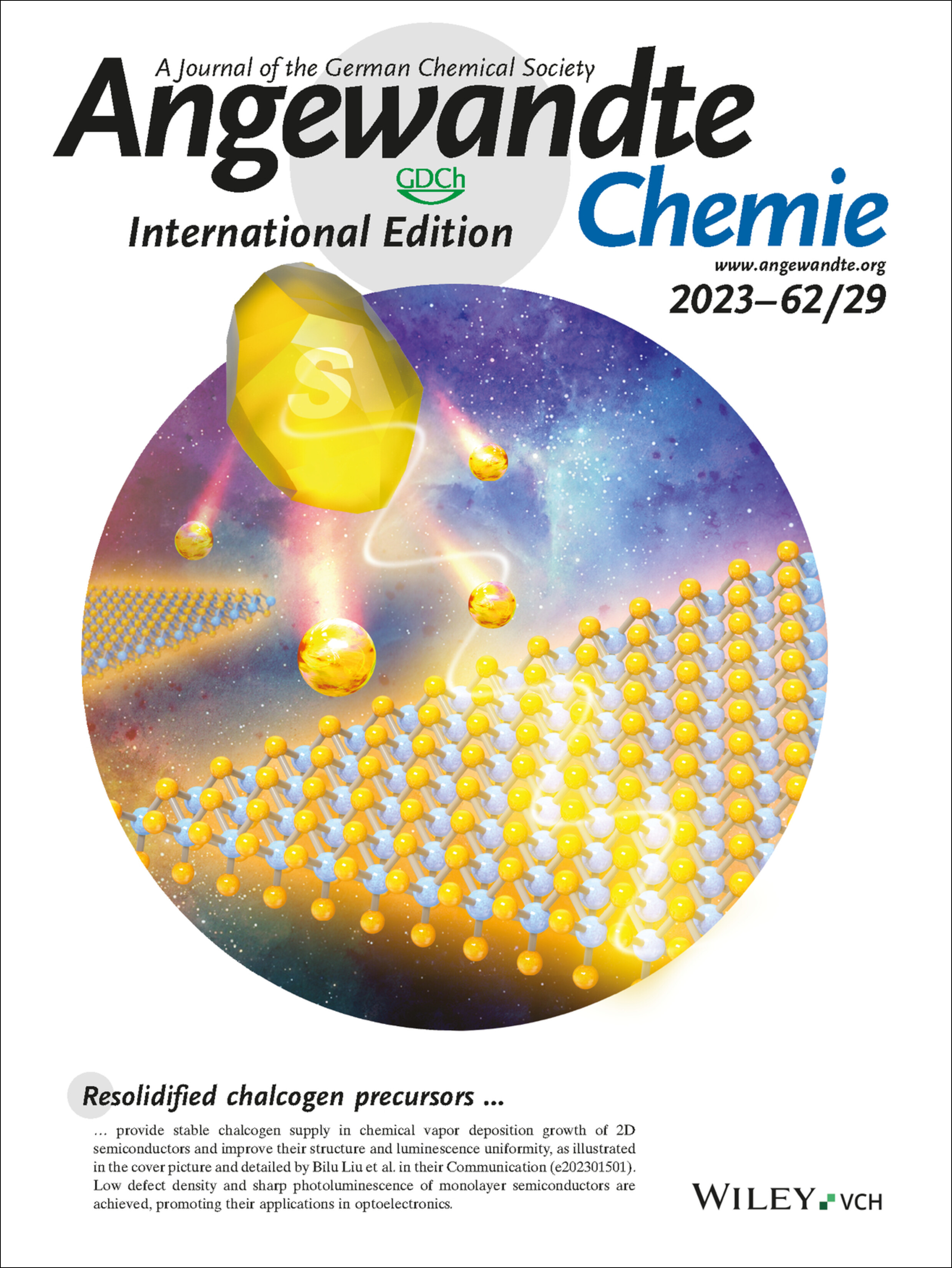
Resolidified chalcogen precursors provide stable chalcogen supply in chemical vapor deposition growth of 2D semiconductors and improve their structure and luminescence uniformity, as illustrated in the cover picture and detailed by Bilu Liu et al. in their Communication (e202301501). Low defect density and sharp photoluminescence of monolayer semiconductors are achieved, promoting their applications in optoelectronics.
Inside Back Cover: Tailoring *H Intermediate Coverage on the CuAl2O4/CuO Catalyst for Enhanced Electrocatalytic CO2 Reduction to Ethanol (Angew. Chem. Int. Ed. 29/2023)
- First Published: 22 May 2023
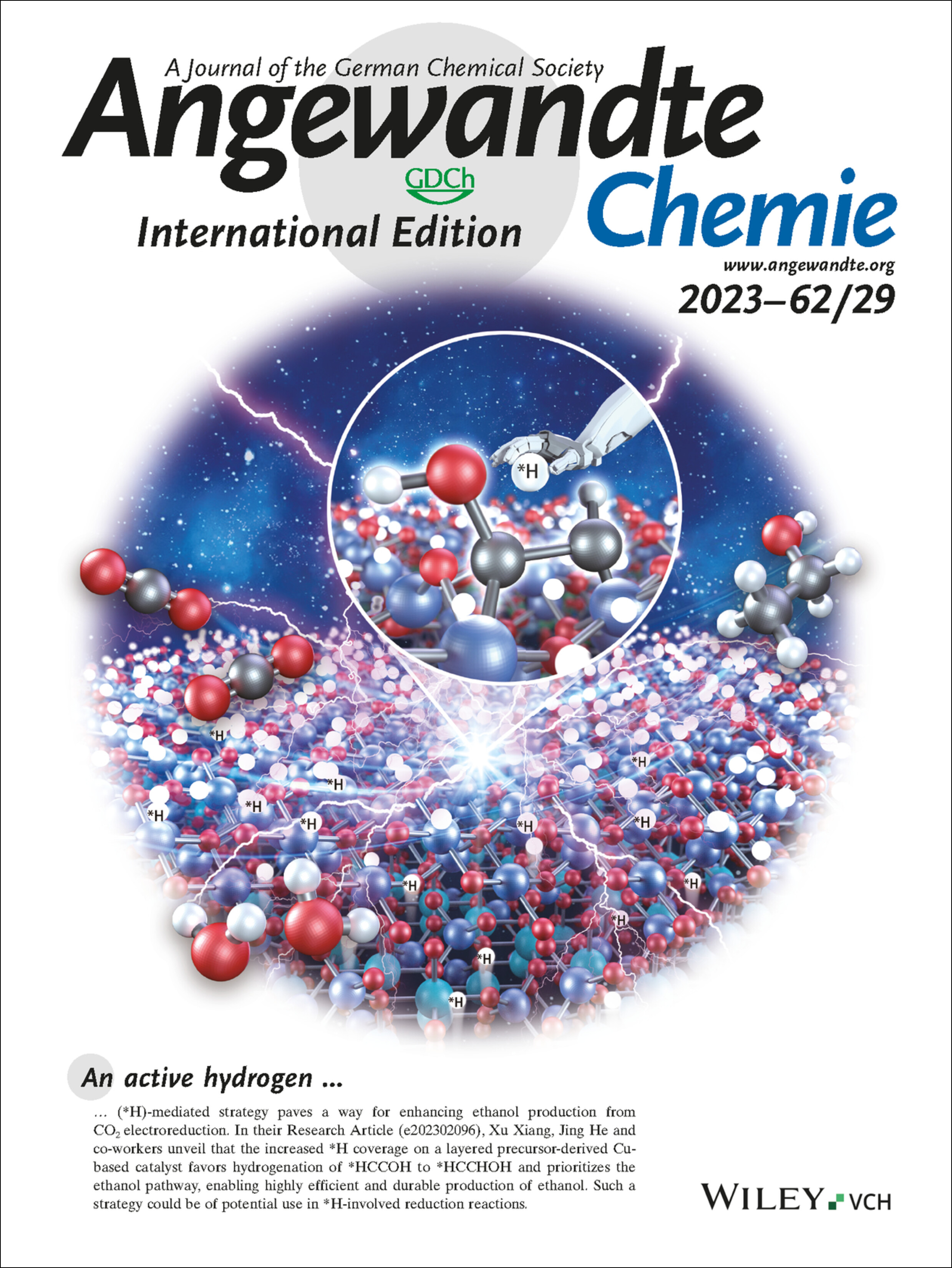
An active hydrogen (*H)-mediated strategy paves a way for enhancing ethanol production from CO2 electroreduction. In their Research Article (e202302096), Xu Xiang, Jing He and co-workers unveil that the increased *H coverage on a layered precursor-derived Cu-based catalyst favors hydrogenation of *HCCOH to *HCCHOH and prioritizes the ethanol pathway, enabling highly efficient and durable production of ethanol. Such a strategy could be of potential use in *H-involved reduction reactions.
Back Cover: Superprotonic Conductivity of MOFs Confining Zwitterionic Sulfamic Acid as Proton Source and Conducting Medium (Angew. Chem. Int. Ed. 29/2023)
- First Published: 20 June 2023
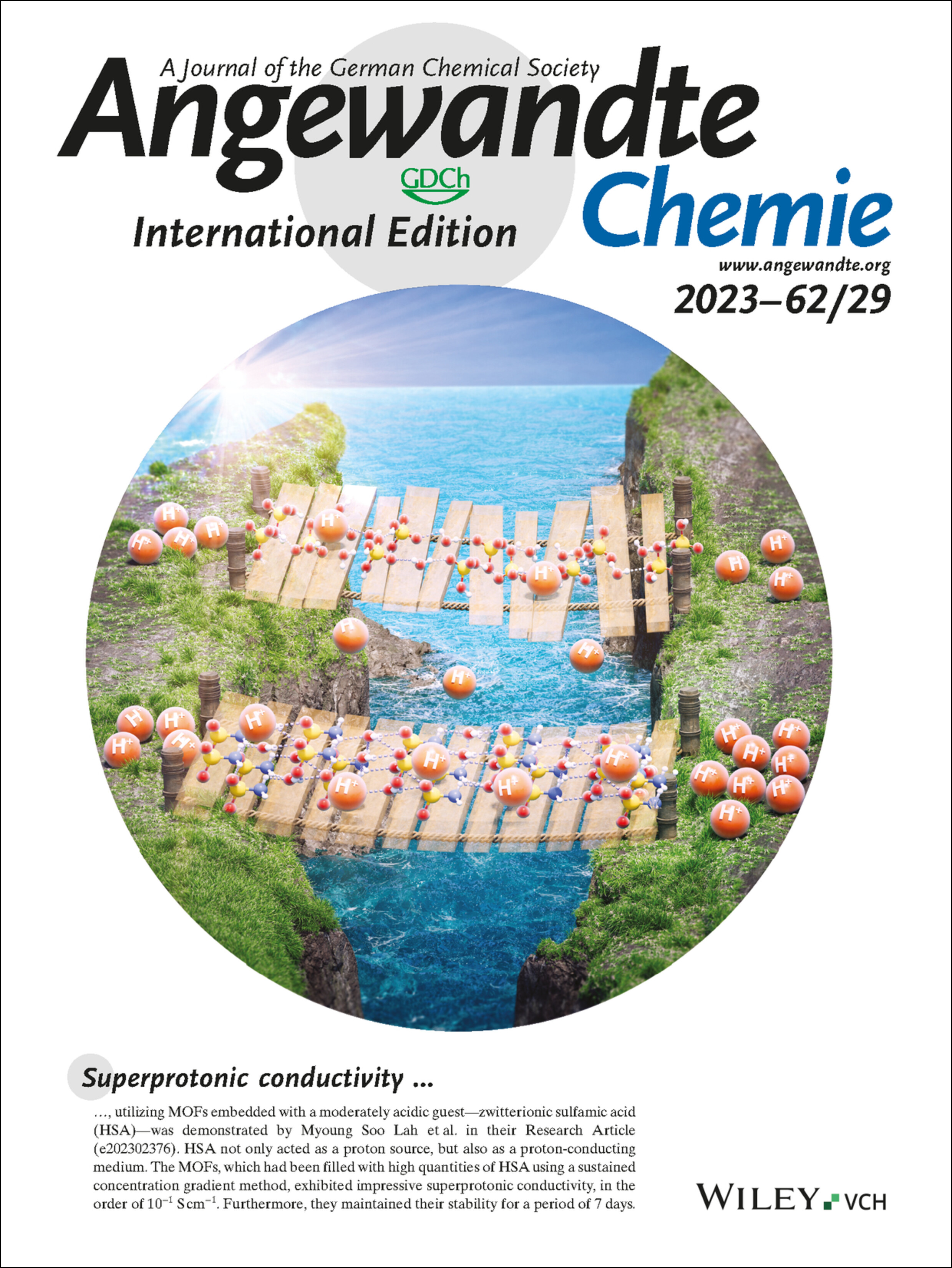
Superprotonic conductivity, utilizing MOFs embedded with a moderately acidic guest—zwitterionic sulfamic acid (HSA)—was demonstrated by Myoung Soo Lah et al. in their Research Article (e202302376). HSA not only acted as a proton source, but also as a proton-conducting medium. The MOFs, which had been filled with high quantities of HSA using a sustained concentration gradient method, exhibited impressive superprotonic conductivity, in the order of 10−1 S cm−1. Furthermore, they maintained their stability for a period of 7 days.
Frontispiece
Frontispiece: Chalcogen-Bond-Induced Double Helix Based on Self-Assembly of a Small Planar Building Block
- First Published: 10 July 2023
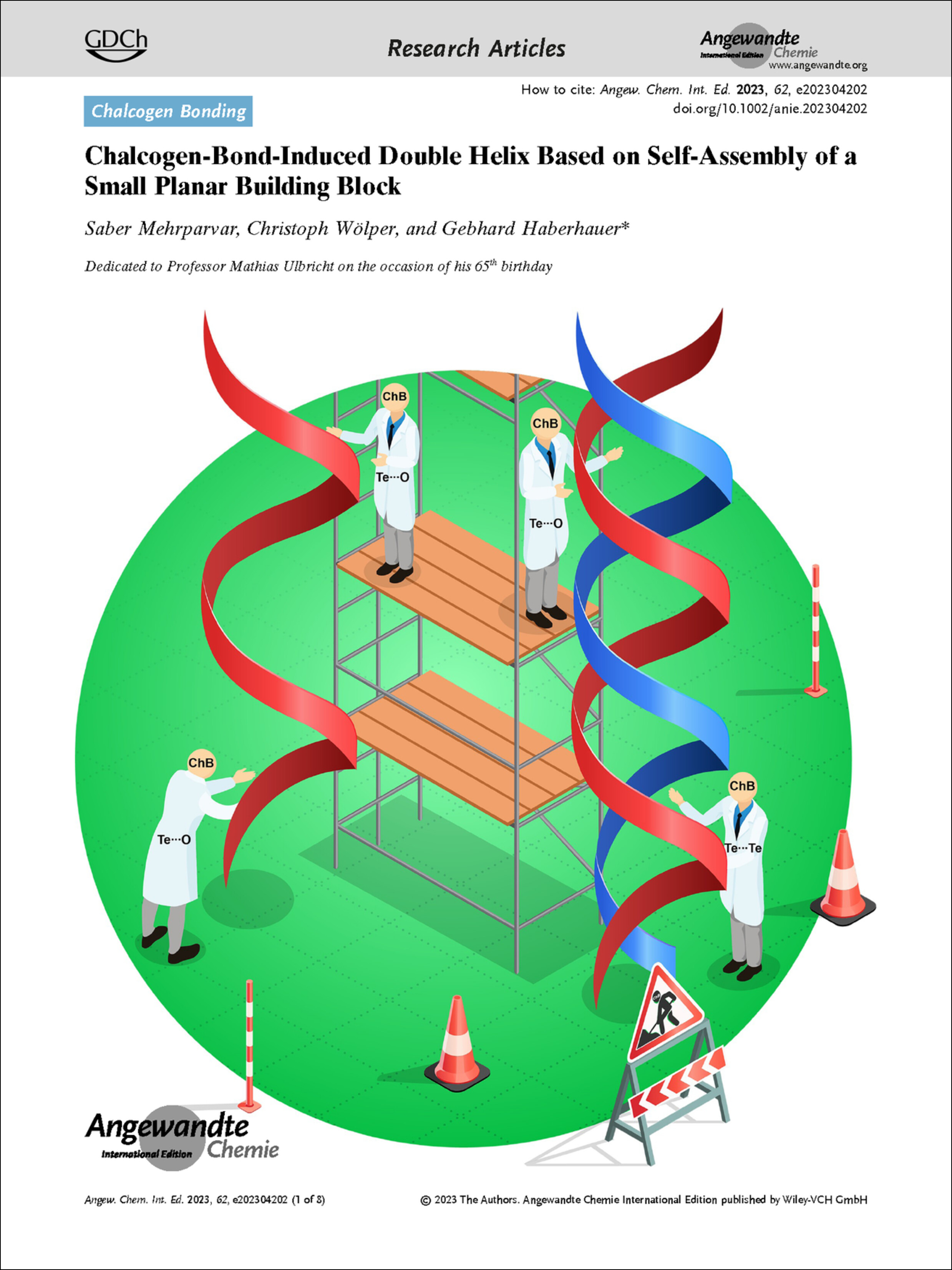
Chalcogen Bond. Chalcogen bonding can play a significant role in designing complex bioinspired structures. In their Research Article (e202304202), Gebhard Haberhauer et al. employ two different types of this interaction to construct single and double helices from planar benzotellurazole amides.
Frontispiece: Amplified Chirality Transfer to Aromatic Molecules through Non-specific Inclusion by Amorphous, Hyperbranched Poly(fluorenevinylene) Derivatives
- First Published: 10 July 2023
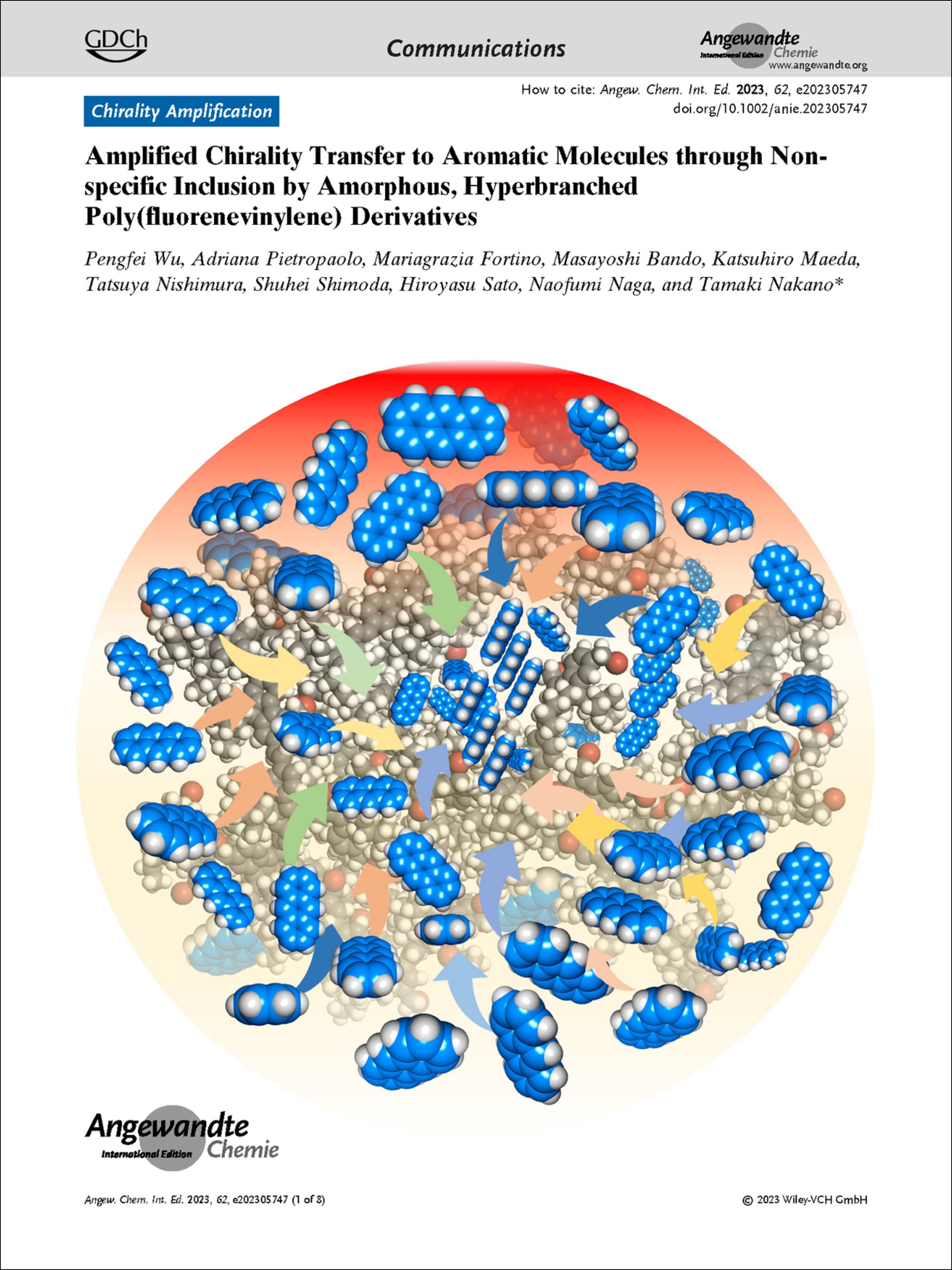
Polymers. In their Communication (e202305747), Tamaki Nakano et al. report the inclusion of aromatic small molecules in the interior space of optically active poly(fluorenevinylene) derivatives. The small molecules exhibit circular dichroism and efficient circularly polarized luminescence.
Graphical Abstract
Corrigenda
Corrigendum: Mo2C-Derived Polyoxometalate for NIR-II Photoacoustic Imaging-Guided Chemodynamic/Photothermal Synergistic Therapy
- First Published: 15 June 2023
Team Profile
Supramolecular Materials Chemistry in the MacLachlan Group
- First Published: 31 May 2023

“Our group is energized by research topics that merge materials chemistry with supramolecular chemistry. We are actively investigating the development of coordination chemistry for host–guest complexes and sensing, and investigating photonic materials prepared through the self-assembly of liquid crystalline biopolymers… In our experience, nearly every good piece of new research involves serendipity.” Find out more about work in the MacLachlan group at the University of British Columbia.
Introducing …
Benedict Josua Elvers
- First Published: 01 June 2023

“If I could be granted a superpower, it would be all-powerful vision so that I could observe reactions in the Schlenk vessel at the molecular level because it would be so cool to understand all reactions on a molecular level, wouldn't it? … In five years, I hope to be a recognized researcher with my own research group.” Find out more about Benedict Josua Elvers in his Introducing … Profile.
Highlights
Aromaticity
A Crowning Achievement: The First Solution-Phase Synthesis of Circumcoronenes
- First Published: 12 May 2023
Minireviews
Polymers Recycling
Photocatalysis as an Effective Tool for Upcycling Polymers into Value-Added Molecules
- First Published: 13 April 2023
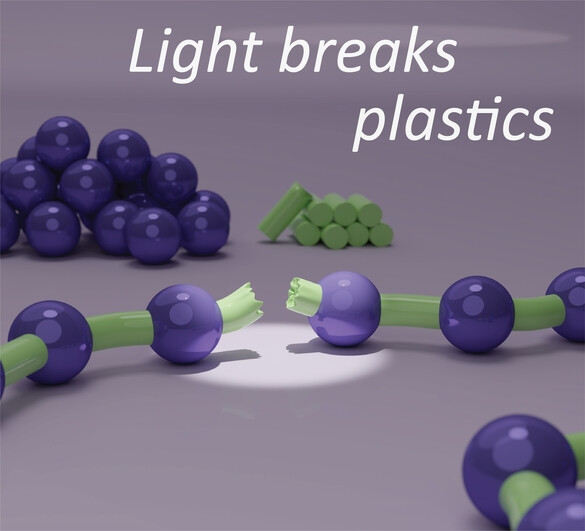
Photocatalysis has recently evolved to a powerful tool to convert plastics directly into value-added organic molecules. Researchers developed distinct light-driven depolymerization strategies for various polymers, ranging from hydroxylated (bio)polymers to real-life polystyrene. These methods operate under mild conditions, show high efficiency, and thus constitute a promising alternative to traditional recycling methods.
Photochemistry
Sulfonium Salts as Acceptors in Electron Donor-Acceptor Complexes
- First Published: 23 March 2023
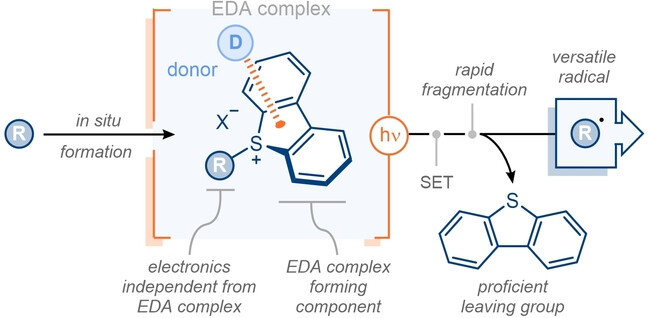
Photoactivation of electron donor-acceptor (EDA) complexes is a sustainable, selective and versatile strategy for the generation of radicals. Sulfonium salt acceptors promise to dramatically expand the range of radicals that can be generated and exploited using EDA chemistry; the use of readily installed “sulfonium tags” relaxes the electronic constraints typically imposed on the parent substrate by an EDA complexation approach.
Reviews
Heterogeneous Catalysis
Carbon Deposit Analysis in Catalyst Deactivation, Regeneration, and Rejuvenation
- First Published: 13 April 2023
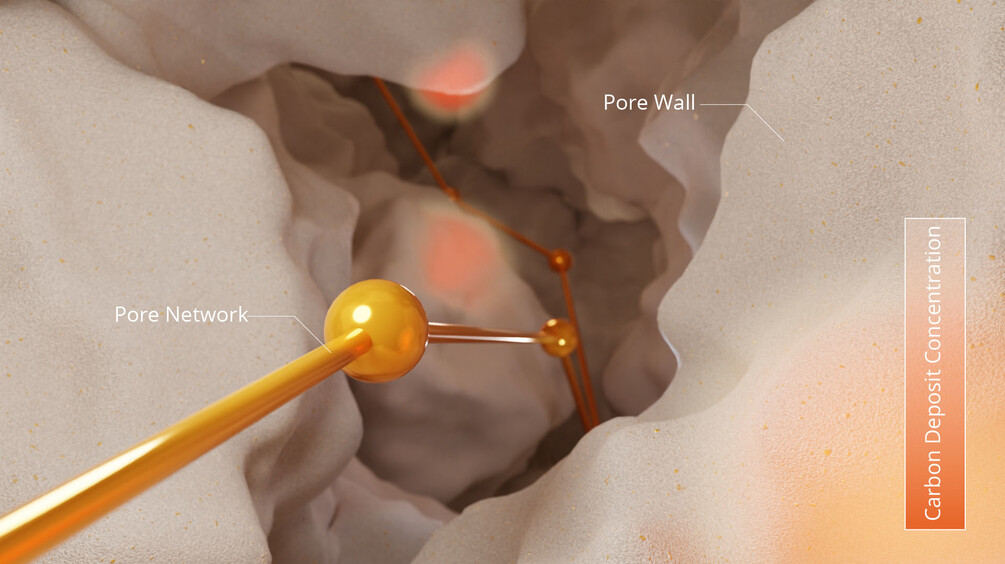
This review article discusses the role of carbon species deposited from various feedstock molecules or formed over time during a catalytic process, including ways to mitigate the effects of these carbon species by catalyst design, regeneration or rejuvenation. This is done for various industrially relevant systems, including the methanol-to-hydrocarbons process. New tools for the direct observation of the 3D-distribution of carbon species within the catalyst pore network are also described.
Responsive MOFs
Traffic Lights for Catalysis: Stimuli-Responsive Molecular and Extended Catalytic Systems
- First Published: 30 March 2023
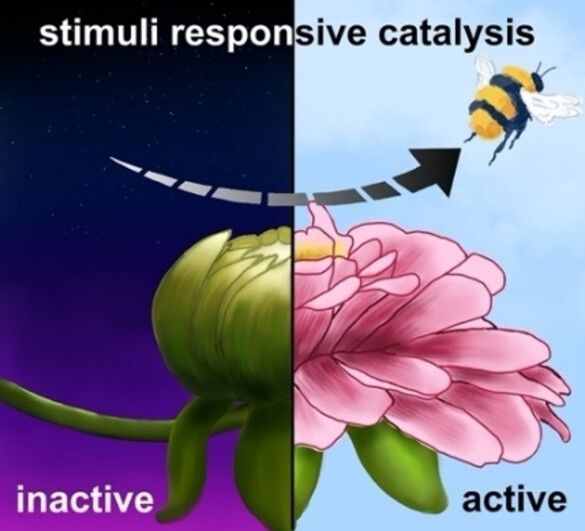
Just as flowers blooming in response to the sun attract bees to continue their natural life cycle, molecules which respond to external stimuli can be used to control catalytic cycles. Development of stimuli-responsive molecular and extended catalytic platforms is a pathway for precise tuning of reaction yield, rate, or enantioselectivity that could pave the way for the next era of sustainable chemistry.
Research Articles
Chalcogen Bonding
Chalcogen-Bond-Induced Double Helix Based on Self-Assembly of a Small Planar Building Block
- First Published: 26 April 2023
Porous Salts
Porous Salts Containing Cationic Al24-Hydroxide-Acetate Clusters from Scalable, Green and Aqueous Synthesis Routes
- First Published: 27 April 2023

The systematic high-throughput investigation of the system AlCl3/CH3COOH/NaOH/H2O led to the discovery of a series of porous salts from readily available starting materials in high yields. In situ crystallisation studies confirm the rapid formation of the highly crystalline compounds within minutes under mild conditions.
Cluster Compounds
Probing Charge-Transfer Processes in a Covalently Linked [Ge9]-Cluster Imine Dyad
- First Published: 27 April 2023
![Probing Charge-Transfer Processes in a Covalently Linked [Ge9]-Cluster Imine Dyad](/cms/asset/70826982-baa1-4983-a311-07fc11fe3d6e/anie202304088-toc-0001-m.jpg)
Silylated [Ge9] clusters form a novel type of chromophore system. Protonation of a covalently cluster-bound imine moiety results in an intense color change from red to green. Transient absorption spectroscopy and DFT calculations on the protonated form reveal ultrafast dynamics upon photoexcitation leading to a charge-transfer between the cluster and the imine moiety, thus giving the proof of principle for a cluster-imine dyad.
Biofilms
Chemical Modification of a Bacterial Siderophore by a Competitor in Dual-Species Biofilms
- First Published: 21 May 2023
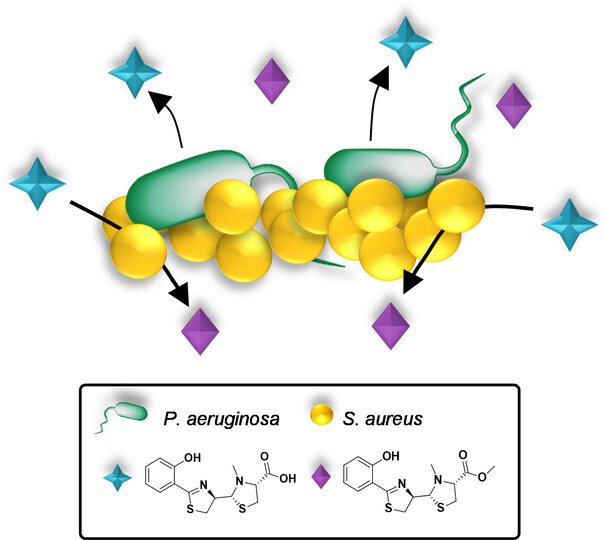
Detailed investigation of the inter-species chemical communication between the human pathogens P. aeruginosa and S. aureus revealed that S. aureus converts pyochelin, an important siderophore secreted by P. aeruginosa, to its less potent pyochelin methyl ester (PME). In addition, PME is sensed by P. aeruginosa and affects metabolite expression, indicating a potential role as signaling molecule for both species.
Electron Transfer
Manipulating Electron-Transfer Events in [Fe4Co4] Cubes via a Mixed-Ligand Approach: The Impact of Elastic Frustration
- First Published: 20 May 2023
![Manipulating Electron-Transfer Events in [Fe4Co4] Cubes via a Mixed-Ligand Approach: The Impact of Elastic Frustration](/cms/asset/ae2d9c15-2911-4924-986e-243b601672b3/anie202301124-toc-0001-m.jpg)
Two cyanide-bridged [Fe4Co4] cubes were prepared via a mixed-ligand approach. The molecular origins of their distinct (incomplete vs. complete) metal-to-metal electron transfer (MMET) properties were identified as the presence and absence of the inter-cluster alkynyl-alkynyl and CH/π interactions. These compete with the cluster-anion interactions, resulting in the underlying elastic frustration and stopping the complete spin transition in 1.
Thermoelectric Materials
Investigating the Role of Vacancies on the Thermoelectric Properties of EuCuSb-Eu2ZnSb2 Alloys
- First Published: 04 May 2023
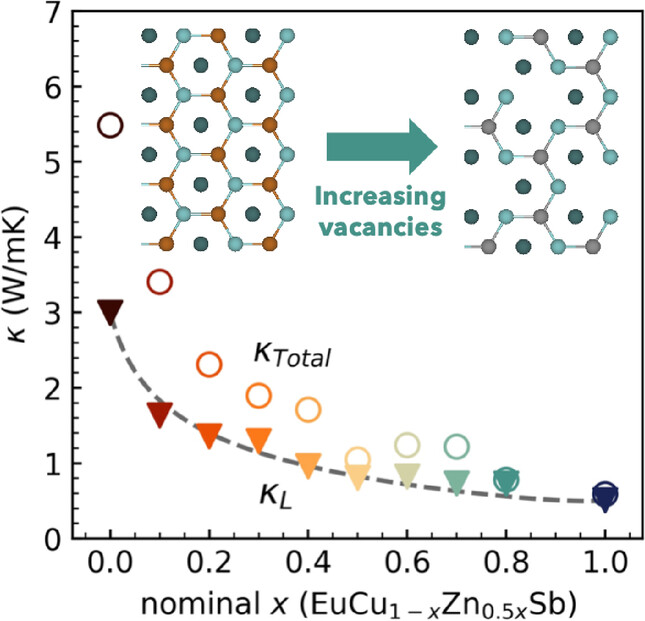
In this work, we investigate the impact of vacancies on the thermoelectric properties of the EuCuSb-EuZn0.5Sb solid solution. Vacancies in the planar honeycomb lattice cause a decrease in sound velocity and a sharp increase in point defect scattering, which combine to yield an 80 % decrease in lattice thermal conductivity. Ultimately, the maximum zT increases from 0.09 to 0.7 as the composition changes from EuCuSb to EuZn0.5Sb.
Supramolecular Chemistry
Development of Tough Thermoplastic Elastomers by Leveraging Rigid–Flexible Supramolecular Segment Interplays
- First Published: 19 May 2023
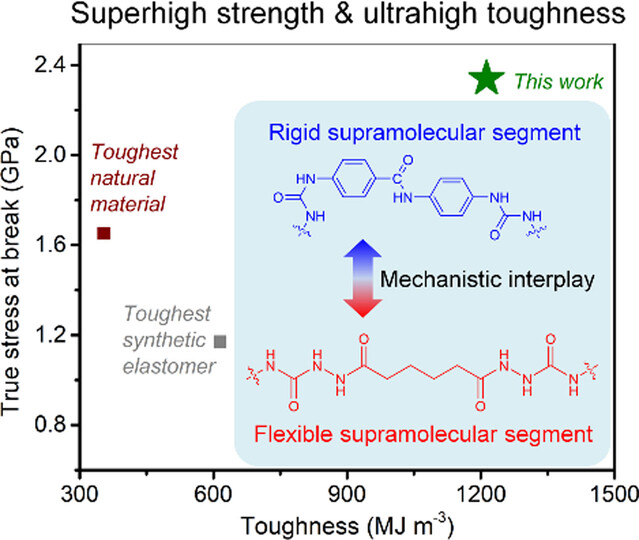
A cooperative strategy for toughening thermoplastic elastomers without toughness–strength trade-off limitations is developed by leveraging the interplays between rigid and flexible supramolecular segments, resulting in the toughest (toughness 1.2 GJ m−3) thermoplastic elastomer thus far. This work presents a general design principle for toughening polymer materials by mismatched supramolecular interactions.
Electrocatalytic CO2 Reduction | Hot Paper
Tailoring *H Intermediate Coverage on the CuAl2O4/CuO Catalyst for Enhanced Electrocatalytic CO2 Reduction to Ethanol
- First Published: 07 April 2023
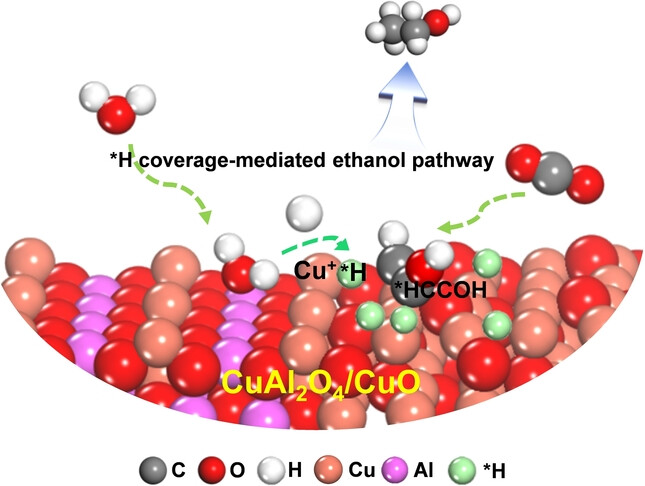
We propose a *H-intermediate-mediating strategy for ethanol electroproduction from CO2RR. The findings reveal that the in situ generated CuAl2O4 in Cu-based catalyst could accelerate water dissociation and tailor *H intermediate coverage, which favors hydrogenation of the *HCCOH to ethanol. This study directs a feasible avenue for mediating *H intermediate coverage and tailoring *H-involved reduction reaction pathways on an efficient and durable Cu-based oxide catalyst.
MOFs for Proton Conduction
Superprotonic Conductivity of MOFs Confining Zwitterionic Sulfamic Acid as Proton Source and Conducting Medium
- First Published: 09 May 2023
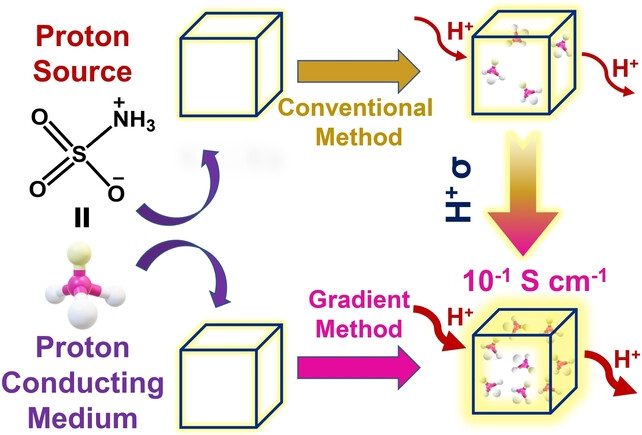
Strategic loading of dual-functioning zwitterionic sulfamic acid in MOFs leads to proton conductivity of the order of 10−1 S cm−1. This high conductivity is the result of higher loading of sulfamic acid, which can act as both a proton source due to its acidity and a conducting medium due to its extensive hydrogen-bonding ability and zwitterion effect.
Synthetic Methods | Hot Paper
Metal-Free Arylation of Benzothiophenes at C4 by Activation as their Benzothiophene S-Oxides
- First Published: 31 March 2023
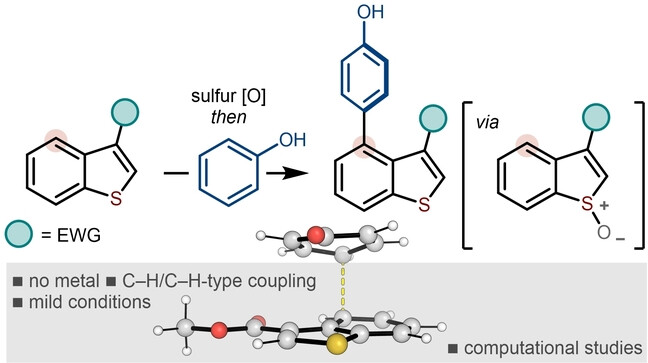
Benzothiophenes are key structures in materials and medicines and methods for their selective C−H functionalization are highly prized. Activation of benzothiophenes bearing electron-withdrawing groups at C3 as their S-oxides enables formal C−H/C−H coupling with phenols to access C4 arylated benzothiophenes. Computational studies suggest the intermediacy of a π-complex between the benzothiophene and a phenoxonium cation.
Fluorescence
A Kinetically Stabilized Nitrogen-Doped Triangulene Cation: Stable and NIR Fluorescent Diradical Cation with Triplet Ground State
- First Published: 22 May 2023
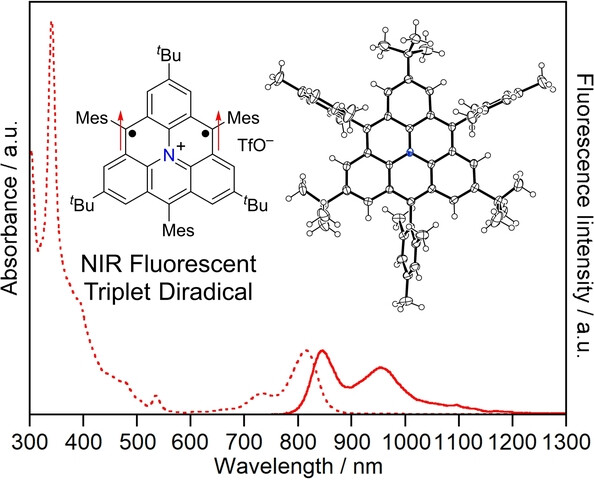
A kinetically-stabilized nitrogen-doped triangulene cation derivative has been synthesized and isolated. It is highly stable even in solution under air and has a triplet ground state with a large singlet-triplet energy gap. In contrast to the triangulene derivative, the nitrogen-doped triangulene cation derivative exhibits near-infrared absorption and emission because the alternancy symmetry of triangulene is broken by the nitrogen cation.
Artificial Synapses
An Aqueous Electrolyte Gated Artificial Synapse with Synaptic Plasticity Selectively Mediated by Biomolecules
- First Published: 13 May 2023

We report an artificial synapse where non-relevant biomolecules (urea, lactic acid (LA) and fructose (Fru)) cannot modulate its plasticity, while only relevant biomolecules (glucose) can selectively activate the device and induce long-term modulation and memory effect. The device works properly in blood serum and shows enhanced synaptic behaviors at high glucose concentrations, suggesting its potential application as artificial neurons in vivo.
Organometallic Chemistry
Alkali-Metal-Alkoxide Powered Zincation of Fluoroarenes Employing Zinc Bis-Amide Zn(TMP)2
- First Published: 23 March 2023
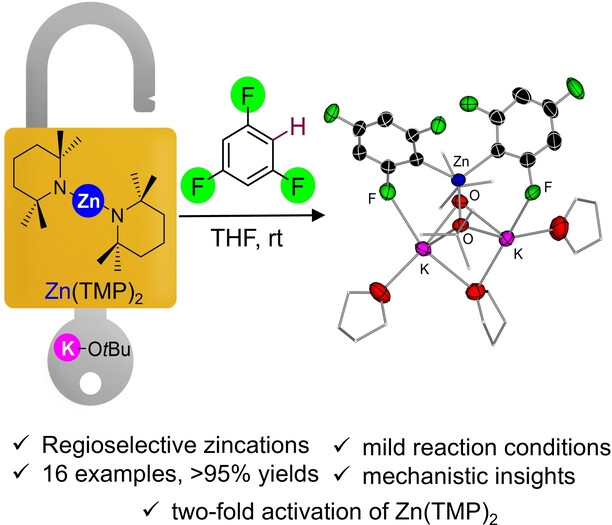
Unlocking the metalation potential of Zn(TMP)2 the addition of KOtBu enables the activation of its amide groups to promote the regioselective zincation of a range of fluoroarenes forming higher order potassium zincates. This methodology can even be extended to non-activated arenes toluene and benzene under mild reaction conditions.
Nanostructures | Hot Paper
Covalently Linked Hexakis(m-Phenylene Ethynylene) Macrocycles as Molecular Nanotubes
- First Published: 04 May 2023
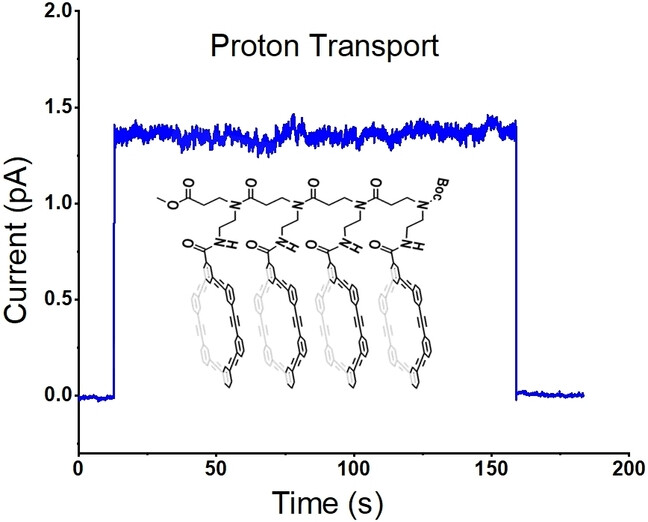
A strategy for constructing organic nanotubes with defined lengths was developed by designing and synthesizing macrocycles with a β-alanine linker. Oligomeric hexakis(m-phenylene ethynylene) macrocycles with four macrocyclic units as molecular nanotubes can form potassium and proton channels across lipid bilayers, with the channels being open continuously for over 60 s.
Supramolecular Chemistry | Very Important Paper
Dynamic Axial-to-Helical Communication Mechanism in Poly[(allenylethynylenephenylene)acetylene]s under External Stimuli
- First Published: 22 May 2023
Nanostructures
Customizable Supraparticles Constructed from Catechol-Terminated Molecular Building Blocks with Controllable Intermolecular Interactions
- First Published: 19 May 2023
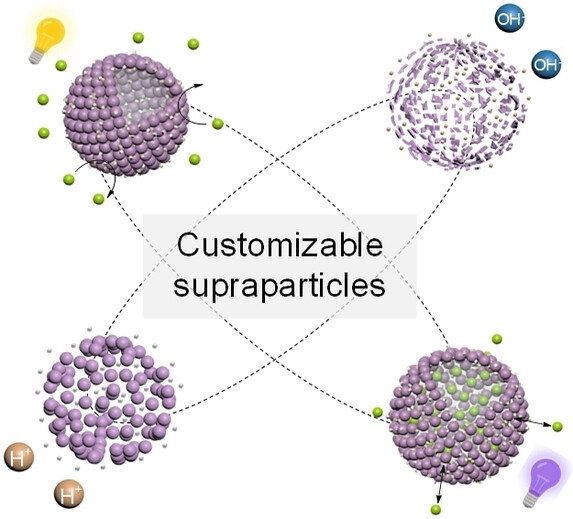
By systematically introducing multiple assembly strategies into the construction of customizable supraparticles based on catechol-terminated molecular building blocks, conventional supraparticles were endowed with structural and functional customization. This strategy paves a way for building multiscale super-assembled materials with high degrees of structural complexity and functional diversity.
Proton Conduction
A Significant Two-Dimensional Structural Transformation in a Coordination Polymer that Changes Its Electronic and Protonic Behavior
- First Published: 12 May 2023

A 2D-to-2D structural transformation with a significant change in the coordination environment within the 2D layer was achieved in a copper-based coordination polymer in water at room temperature. The transformation led to large changes in the physical properties of the coordination polymers, such as proton conductivity and magnetism.
Nitrogen Reduction Reaction | Hot Paper
Na-Ion Batteries
A Stress Self-Adaptive Structure to Suppress the Chemo-mechanical Degradation for High Rate and Ultralong Cycle Life Sodium Ion Batteries
- First Published: 21 April 2023
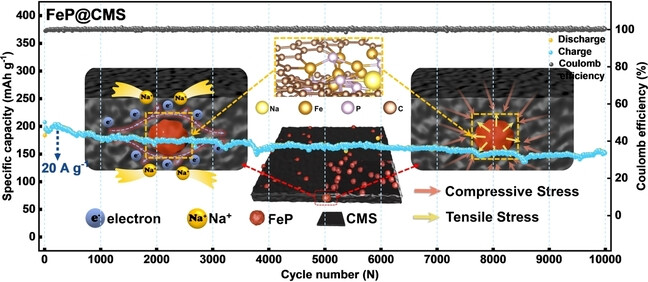
In this work, we report a novel architecture with FeP nanodots fully embedded in nitrogen doped carbon microplates skeleton (FeP@CMS) via the spatial confinement of carbon quantum dots (CQDs) . Such a structure allows the stress transfer between FeP nanodots and self-adaptive carbon matrix in sodium storage, which overcomes the intrinsic chemo-mechanical degradation of metal phosphides during long-term cycling.
Imaging Agents
A Concerted Enzymatic and Bioorthogonal Approach for Extra- and Intracellular Activation of Environment-Sensitive Ruthenium(II)-Based Imaging Probes and Photosensitizers
- First Published: 16 May 2023

A concerted strategy involving enzyme-instructed self-assembly to target overexpressed alkaline phosphatases in cancer cells and bioorthogonal reactions for controllable extracellular and intracellular activation of RuII-based imaging probes and photosensitizers is presented. The emission enhancement, lifetime extension, and (photo)cytotoxicity of the resulting RuII supramolecular assemblies were explored extracellularly and intracellularly.
Heterogeneous Catalysis
Cu-Bound Formates are Main Reaction Intermediates during CO2 Hydrogenation to Methanol over Cu/ZrO2
- First Published: 22 May 2023
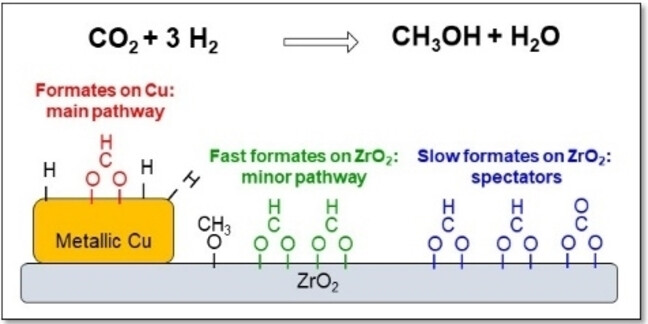
Three different types of formates were observed at the surface of a Cu/ZrO2 catalyst during the hydrogenation of CO2 to methanol. A Cu-bound formate representing only about 7 % of formates exhibited a high reactivity and was the only formate that could account for the production of methanol. The two other surface formates were located on the ZrO2 surface and exhibited significantly lower decomposition rates.
Theranostics
Asymmetric Catalysis
Enantioselective Hydroalkenylation and Hydroalkynylation of Alkenes Enabled by a Transient Directing Group: Catalyst Generality through Rigidification
- First Published: 04 May 2023
Gold Catalysis | Very Important Paper
Unlocking Migratory Insertion in Gold Redox Catalysis
- First Published: 15 May 2023

A gold(I)-catalyzed iodo-alkynylation of benzyne involving the merging of challenging migratory insertion and an oxidative addition process in the AuI/AuIII catalytic cycle has been reported. It represents important progress within the field of gold redox couple chemistry and in particular in the migratory insertion topic.
CO2 Reduction
Simultaneous Generation of H2O2 and Formate by Co-Electrolysis of Water and CO2 over Bifunctional Zn/SnO2 Nanodots
- First Published: 02 May 2023
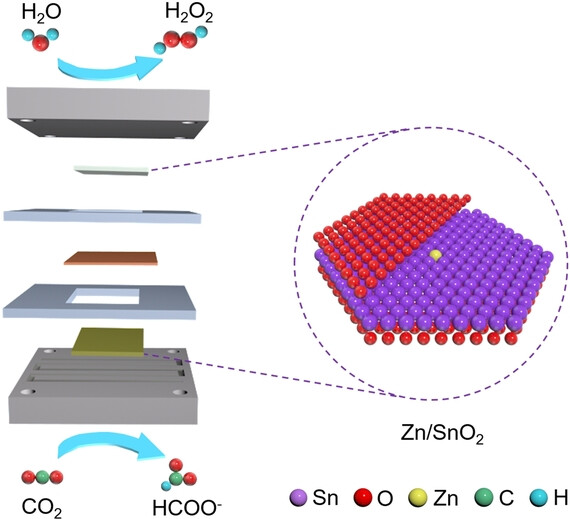
An innovative pair-electrosynthesis system for the coproduction of H2O2 and formate was constructed with the bifunctional electrocatalyst Zn/SnO2 nanodots, achieving high selectivities and excellent productivities at large current densities. The role of the Zn dopant was revealed by density functional theory (DFT) calculations and (quasi)-in situ characterizations.
Luminescence
Multistate Aggregation-Induced Chiroptical Properties of Enantiopure Disulfide-Mediated Bispyrene Macrocycles
- First Published: 09 May 2023

A diastereoselective double thiol-ene addition onto a bis enol ether macrocycle provides chiral disulfide bispyrene macrocycles able to exhibit excimer aggregation-induced emission predominantly. Upon increasing the water content, ECD and CPL monitoring evidence multistate chiroptical properties, rationalized by TDDFT calculations. Langmuir–Blodgett films and AFM studies help decipher the organization of the luminophores at the interface of water.
Benzimidazole Synthesis | Hot Paper
New Radical Route and Insight for the Highly Efficient Synthesis of Benzimidazoles Integrated with Hydrogen Evolution
- First Published: 19 May 2023
H-bonded Organic Frameworks
Chemically Gradient Hydrogen-Bonded Organic Framework Crystal Film
- First Published: 22 May 2023
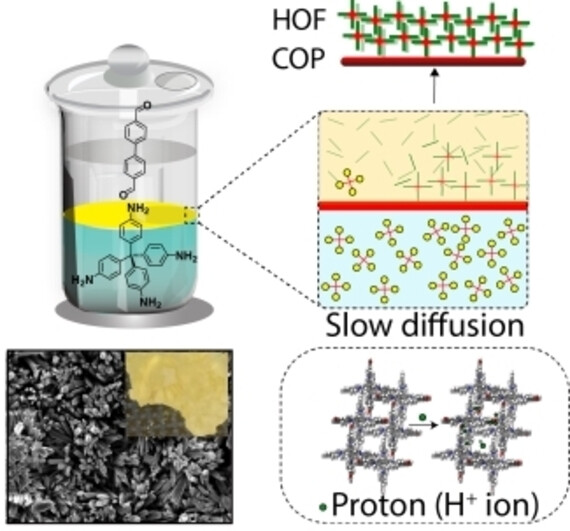
We introduce a novel chemical gradient strategy to fabricate a crystal-deposited HOF on an in situ grown polymer film. The fabricated film showed versatility in chemical bonding along its thickness from covalent to hydrogen-bonded network and showed improved proton conductivity compared to its polymeric analog.
Covalent Organic Frameworks | Hot Paper
Solar Light Driven H2O2 Production and Selective Oxidations Using a Covalent Organic Framework Photocatalyst Prepared by a Multicomponent Reaction
- First Published: 07 May 2023
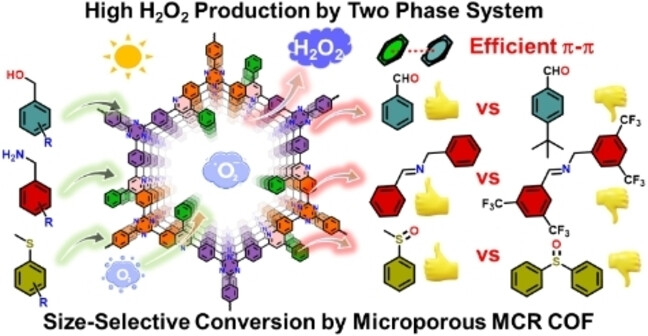
A covalent organic framework (COF) prepared via the multicomponent Povarov reaction shows a high and long-term stable activity for photocatalytic H2O2 production and size-selective photocatalytic oxidation. The COF can be further used as photocatalyst for a range of important aerobic oxidation reactions including the conversion of alcohols to aldehydes, amines to imines and sulfides to sulfoxides.
Solar Cells | Very Important Paper
Extending the π-Conjugated System in Spiro-Type Hole Transport Material Enhances the Efficiency and Stability of Perovskite Solar Modules
- First Published: 15 May 2023
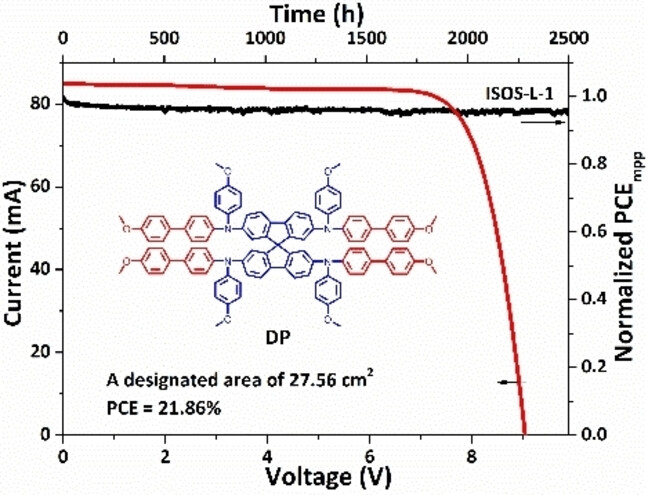
A novel spiro-type hole transport material (HTM) was developed by extending the π-conjugated system (DP). The new HTM features a stabilized HOMO level, a higher glass transition temperature, and improved morphology on the perovskite layer compared to spiro-OMeTAD. When incorporated into an n-i-p device, the DP-based HTM achieved a remarkable power conversion efficiency of 25.24 % for small-area devices and 21.86 % for modules.
Organic Electronics
The Influence of Regiochemistry on the Performance of Organic Mixed Ionic and Electronic Conductors
- First Published: 19 May 2023
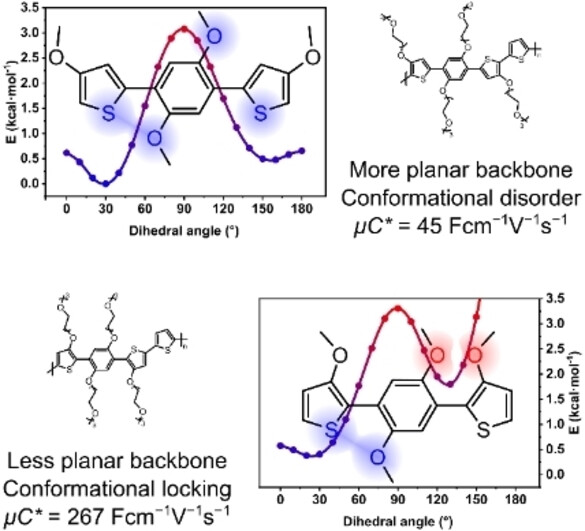
Investigating the influence of sidechain regiochemistry on a series of thiophene-based mixed ionic-electronic conducting polymers, the degree of conformational disorder is found to be a crucial indicator of performance. Maximising non-covalent planarising interactions and polaronic charge delocalisation during molecular design must consequently be carefully weighed against considerations around conformational restrictions.
Blood-Brain Barrier
Biomimetic Nanocomposites Camouflaged with Hybrid Cell Membranes for Accurate Therapy of Early-Stage Glioma
- First Published: 17 May 2023

Hybrid cell membranes (HMs) consisting of brain metastatic breast cancer cell membranes and glioma cell membranes were prepared and coated onto drug-loaded nanoparticles. The obtained HMGINPs inherited good blood-brain-barrier penetration and homologous glioma targeting ability from the two types of source cells, and exhibited superior therapeutic efficacy against early-stage glioma.
Aqueous Zn Batteries | Very Important Paper
Regulated Ion/Electron-Conducting Interphase Enables Stable Zinc-Metal Anodes for Aqueous Zinc-Ions Batteries
- First Published: 22 May 2023
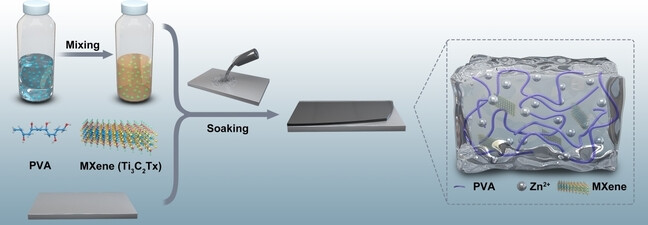
A composite anode of metallic zinc (Zn) with ion and electron-conducting interphase was prepared for Zn-ion batteries. This novel structure suppresses the side reactions and regulates the Zn deposition due to the fast ionic/electronic transport and high Young's modulus, thus achieving long-cycling aqueous Zn-ion batteries.
Perovskites
Rashba Band Splitting and Bulk Photovoltaic Effect Induced by Halogen Bonds in Hybrid Layered Perovskites
- First Published: 17 May 2023
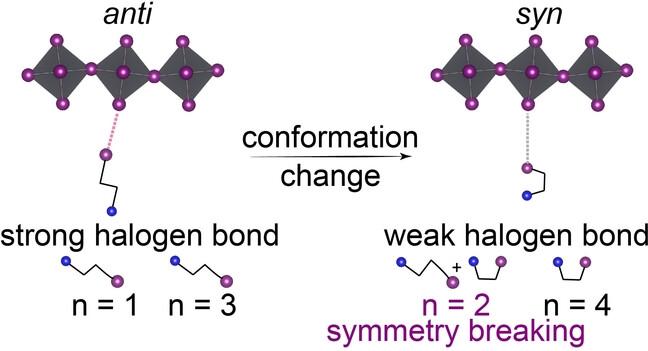
We reported a new series of 2D perovskites featuring thickness-dependent hydrogen and halogen bonding interactions. The strength of non-covalent interaction has a direct impact on the structure symmetry and optoelectronic properties. Stronger halogen interaction leads to centrosymmetry, whereas weaker halogen bonds give rise to non-centrosymmetric structures, Rashba splitting, suppressed radiative recombination, and bulk photovoltaic effect.
Macromolecular Chemistry
A General Autofluorescence Method to Characterize Polymerization Progress
- First Published: 19 May 2023
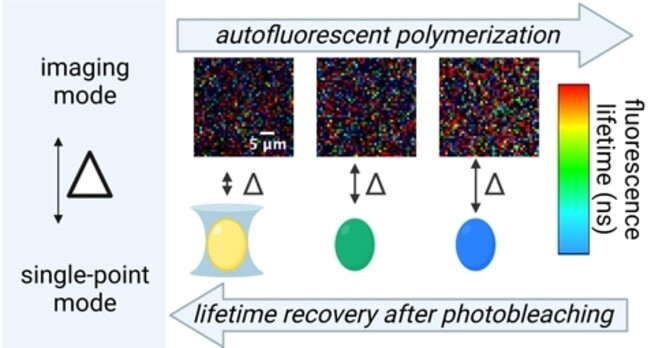
A potentially general autofluorescence method that does not rely on traditional fluorogenic functional groups enables real-time/in-line spectroscopic monitoring of polymerization progress. Fluorescence lifetime recovery after photobleaching (FLRAP) is developed and demonstrated. Changes in (auto)fluorescence lifetime recovery after photobleaching correlate linearly with polymer degree of cure.
Electrochemiluminescence
Bioinspired Single-Atom Sites Enable Efficient Oxygen Activation for Switching Anodic/Cathodic Electrochemiluminescence
- First Published: 21 April 2023
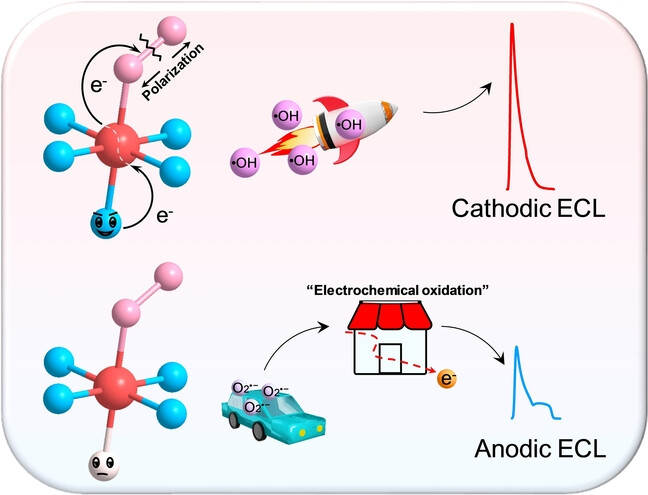
Tailoring axial coordination of Fe sites for charge redistribution realizes efficient and selective catalytic O2 activation to generate specific active intermediates. Highly active hydroxyl radicals produced by axial N-involved systems enable direct cathodic electrochemiluminescence, while C-decorated catalysts preferentially form superoxide anion radicals and only present anodic luminescence.
Luminescence
Multiple Helicenes Defected by Heteroatoms and Heptagons with Narrow Emissions and Superior Photoluminescence Quantum Yields
- First Published: 17 May 2023
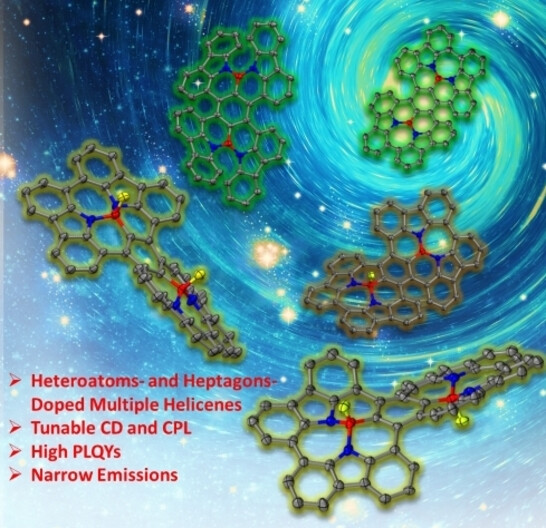
A series of heteroatomic- and heptagons- doped multiple helicenes were successfully synthesized and confirmed by single crystal X-ray diffraction analysis. They exhibit distinguished circularly polarized luminescence (CPL) and circular dichroism (CD) signals, with high photoluminescence quantum yields (PLQYs) and narrow full-width-at-half-maximum (FWHM) values.
Nonlinear Optics
Design of the Ionic Organic Nonlinear Optical Material NH4[LiC3H(CH3)O4] with Ultrawide Band Gap and Moderate Birefringence
- First Published: 22 May 2023
![Design of the Ionic Organic Nonlinear Optical Material NH4[LiC3H(CH3)O4] with Ultrawide Band Gap and Moderate Birefringence](/cms/asset/5cb5f3c9-4265-4d11-8f9e-967f13522ac8/anie202304858-toc-0001-m.jpg)
Based on the excellent organic flexible π-conjugated [C3H(CH3)O4]2− unit, through reasonable nonlinear optical (NLO)-favourable layered design, a deep-ultraviolet ionic organic nonlinear optical crystal, NH4[LiC3H(CH3)O4], with an ultrawide band gap and moderate birefringence was successfully obtained.
Hydrogen Evolution | Hot Paper
Imaging the Footprint of Nanoscale Electrochemical Reactions for Assessing Synergistic Hydrogen Evolution
- First Published: 22 May 2023
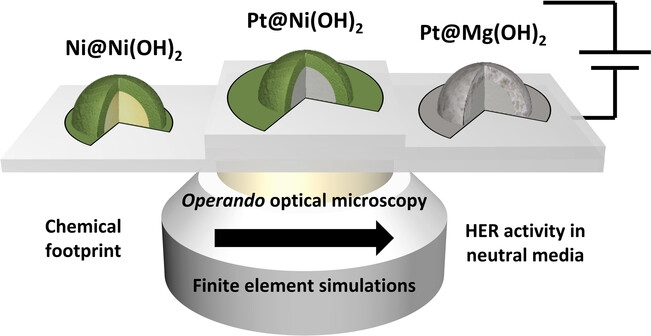
This study proposes a new optical microscopy technique to measure the synergistic effect of metal hydroxide coatings on the hydrogen evolution reaction at the individual particle level in neutral media. The technique involves using hydroxide halo formation as a footprint of the reaction, and can provide real-time operando quantification of catalytic activity.
Photochemistry
Photochemically-Driven CO2 Release Using a Metastable-State Photoacid for Energy Efficient Direct Air Capture
- First Published: 17 May 2023
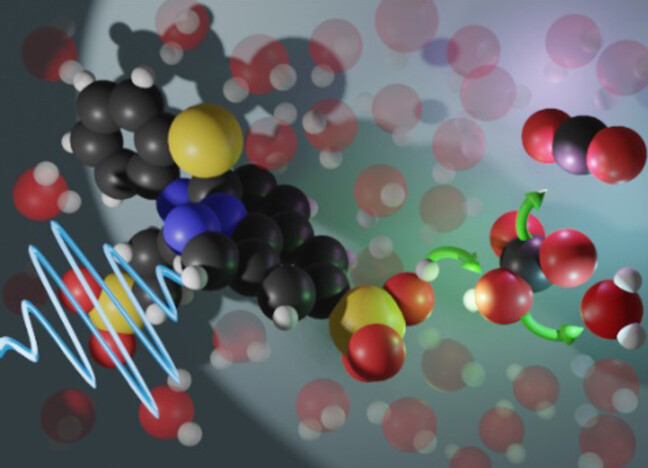
On-demand CO2 release under ambient conditions using light instead of heat is achieved for simulated and amino acid-based direct air capture systems by regulating solution pHs via a photoinduced proton transfer of a reversible metastable-state photoacid, leading to energetically sustainable and economically feasible climate change mitigation solutions using solar energy.
SuFEx Chemistry
Ex situ Generation of Thiazyl Trifluoride (NSF3) as a Gaseous SuFEx Hub
- First Published: 18 May 2023

Here we report a synthetic procedure for the efficient ex situ generation of thiazyl trifluoride gas (N≡SF3) as a new Sulfur(VI)-Fluoride Exchange hub. In typical SuFEx fashion, this triple-bonded azasulfur(VI) fluoride reagent and its mono-substituted derivatives react highly effectively with various nucleophiles to deliver a library of unreported thiazynes.
Polymerization | Very Important Paper
Stochastic Simulation of Controlled Radical Polymerization Forming Dendritic Hyperbranched Polymers
- First Published: 17 May 2023
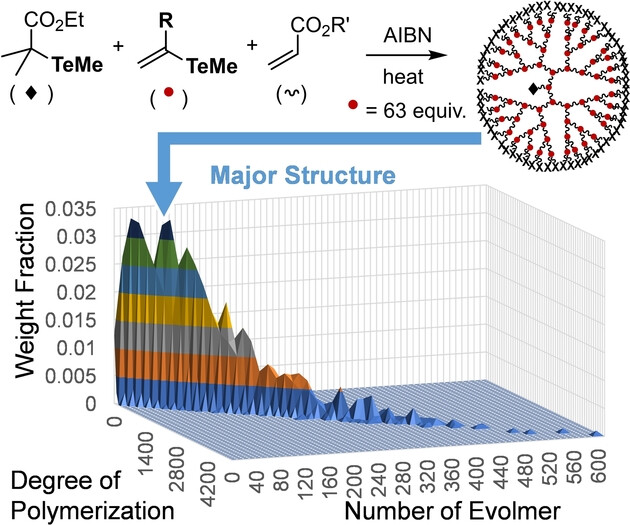
Stochastic simulation of the formation process of hyperbranched polymers (HBPs) based on the reversible deactivation radical polymerization using a branch-inducing monomer, evolmer, has been carried out. The results suggest that the observed dispersities (Đ=1.5–2) originated from the distribution of branch numbers and that the branch structures are well controlled. Furthermore, the majority of HBPs have structures close to the ideal one.
Metal-Organic Frameworks | Hot Paper
Evidence of a Uranium-Paddlewheel Node in a Catecholate-Based Metal–Organic Framework
- First Published: 19 May 2023
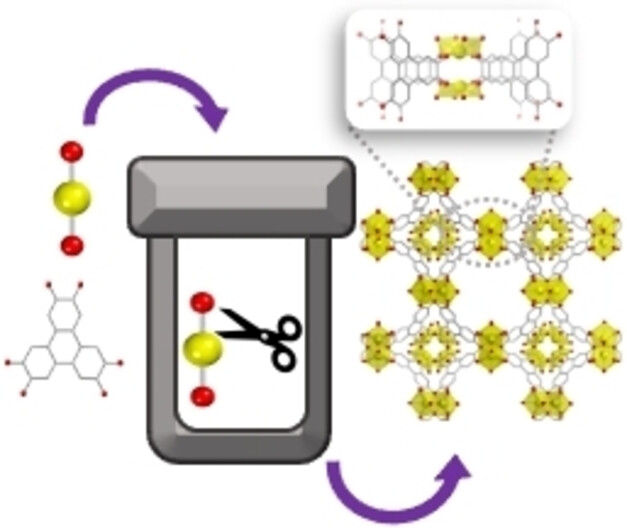
Through solvothermal combination of uranyl and a redox-active linker, we reduced the U−O bonds and subsequently formed a metal-organic framework built from a uranium paddlewheel node. This paddlewheel node, where two uranium atoms are connected by four hexahydroxytriphenylene species and capped with water moieties, is unprecedented.
Perovskite Electrocatalysts
Phase Transition Engineering of Host Perovskite toward Optimal Exsolution-facilitated Catalysts for Carbon Dioxide Electrolysis
- First Published: 23 May 2023
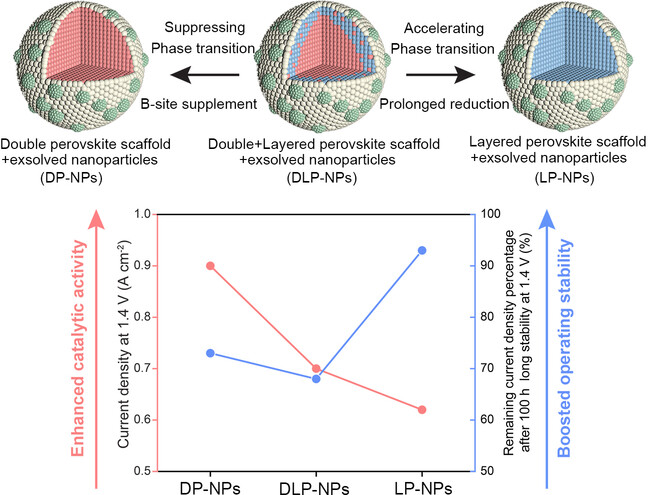
We have implemented a set of strategies to precisely control the phase evolution of host perovskite without compromising exsolution. Using carbon dioxide electrolysis as an example, we demonstrated how regulating phase structure can enhance the activity and stability of exsolved perovskites, emphasizing the importance of phase evolution control in catalytic chemistry occurring on perovskites with exsolution.
Photoresponsive Materials
Sequential Multistep Excited-State Structural Transformations in N,N′-Diphenyl-dihydrodibenzo[a,c]phenazine Fluorophores
- First Published: 15 May 2023
![Sequential Multistep Excited-State Structural Transformations in N,N′-Diphenyl-dihydrodibenzo[a,c]phenazine Fluorophores](/cms/asset/3d5f7f6e-1d9b-4383-acf0-3687dd9ab339/anie202305572-toc-0001-m.jpg)
Substituent engineering of dihydrodibenzo[a,c]phenazine-based fluorophores was demonstrated to access broadband triple fluorescent emissions from ≈350 to ≈850 nm. Mechanistic studies revealed that the steric effect modulates the excited-state potential energy surface, enabling the molecule to undergo multistep transformation along the sequence of bent, planar, and twisted structures.
Sulfur Chemistry | Very Important Paper
Synthesis of N-Monosubstituted Sulfondiimines by Metal-free Iminations of Sulfilimium Salts
- First Published: 04 May 2023

We report an operationally simple and safe method for the synthesis of N-monosubstituted sulfondiimines starting from stable sulfiliminium salts. This metal-free procedure employs a combination of iodine(III) reagents with iodine and 1,8-diazabicyclo[5.4.0]undec-7-en (DBU), providing particularly, S,S-dialkyl-substituted sulfondiimines in up to 85 % yield. Mechanistically, electrophilic nitrene cations are suggested as the reactive intermediates.
Theranostics | Hot Paper
A Radio-Pharmaceutical Fluorescent Probe for Synergistic Cancer Radiotherapy and Ratiometric Imaging of Tumor Reactive Oxygen Species
- First Published: 23 May 2023
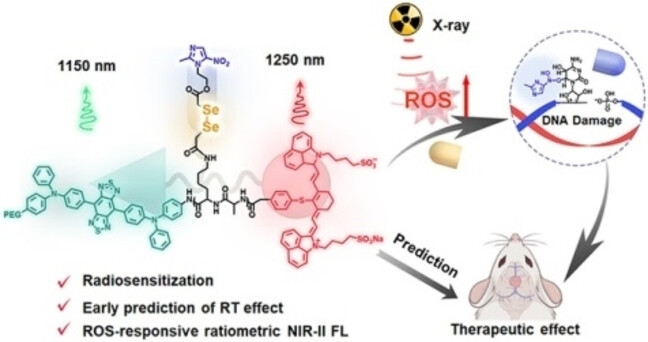
An optical imaging agent and radiosensitized pharmaceutical containing diselenide and metronidazole was developed to realize the radiosensitizing effect and report the ROS levels through ratiometric NIR-II fluorescence imaging. This molecule exhibited synergetic radiosensitization and could monitor the radiotherapy response for both hypoxic tumors and orthotopic glioma.
Asymmetric Catalysis
Enantioselective Synthesis of Biscyclopropanes Using Alkynes as Dicarbene Equivalents
- First Published: 22 May 2023
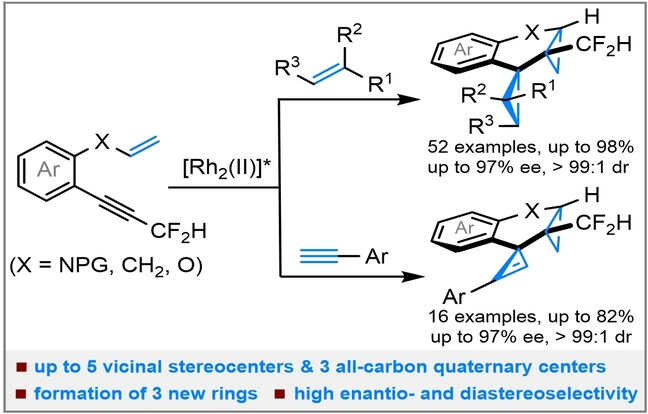
A chiral Rh2(II)-catalyzed double cyclopropanation of CF2H-substituted enyne with alkenes is reported. The bicyclopropanes with 4–5 vicinal stereocenters and 2–3 all-carbon quaternary centers were constructed with excellent stereoselectivity in one step. The method was extended to the cyclopropanation/cyclopropenation. In these processes, the functional alkyne is used as a dicarbene equivalent and 3 new rings are formed.
Soft Matter
Tetrazole Linkages as Photoactivated Fuels for Light-Regulated Photothermal/Photocatalytic Propulsion of Versatile Polymer Nanoplatforms
- First Published: 24 May 2023
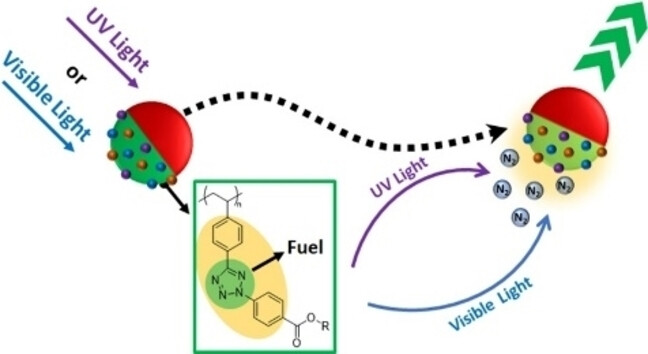
Photoactivated versatile polymer nanoplatforms with asymmetric geometry enable on-demand integration of various functionalities via tetrazole linkages. In response to UV or visible light, tetrazoles as light-triggered fuels simultaneously perform photocatalytic N2 release and photothermal conversion within the polymer nanoplatforms for powering the multimode synergistic propulsion, thus showing potential in bio-applications.
Mesoporous Oxide Catalysts
Efficient Selective Oxidation of Aromatic Alkanes by Double Cobalt Active Sites over Oxygen Vacancy-rich Mesoporous Co3O4
- First Published: 24 May 2023

Oxygen vacancy-rich mesoporous Co3O4 (mCo3O4) was synthesized by a simple ligand-assisted self-assembly method. Benefitting from abundant oxygen vacancies and the mesoporous structure of mCo3O4, a unique catalytic path was presented with direct oxidation of aromatic alkanes to aromatic ketones rather than the conventional stepwise oxidation to alcohols and then to ketones.
Polymerization
Synthesis of Polyethyleneimines from the Manganese-Catalysed Coupling of Ethylene Glycol and Ethylenediamine
- First Published: 17 May 2023
Communications
Chirality Amplification
Amplified Chirality Transfer to Aromatic Molecules through Non-specific Inclusion by Amorphous, Hyperbranched Poly(fluorenevinylene) Derivatives
- First Published: 19 May 2023
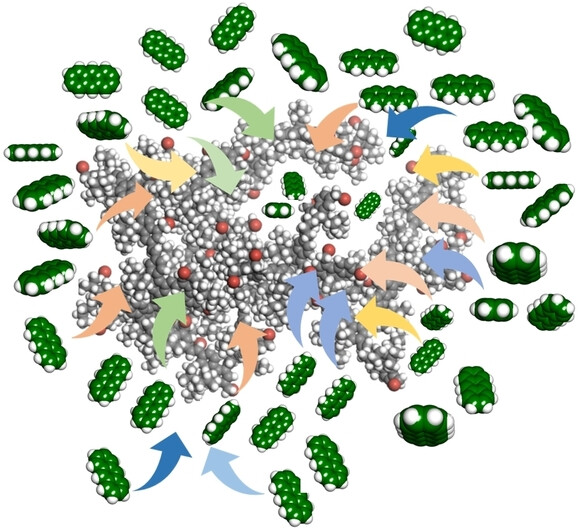
Optically active, hyperbranched poly(fluorenevinylene) derivatives have been shown to include aromatic small molecules in their interior space. These small molecules form liquid-crystal-like intermolecular arrangements and exhibit clear circular dichroism and efficient circularly polarized luminescence with remarkably amplified anisotropy.
Li-Ion Batteries
Cyclotetrabenzil Derivatives for Electrochemical Lithium-Ion Storage
- First Published: 17 April 2023
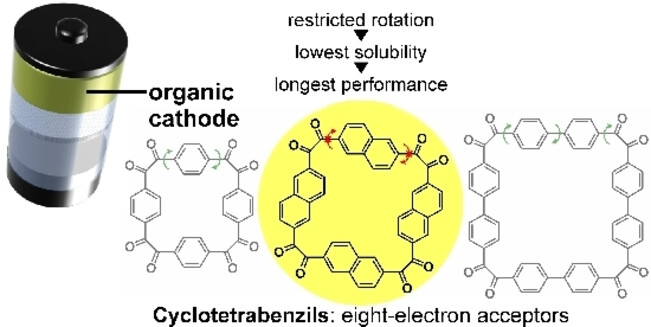
Naphthalene-based cyclotetrabenzil octaketone is an excellent cathode material for lithium-ion batteries. It reversibly accepts eight electrons per molecule, has a specific capacity of 279 mAh g−1, and shows stable cycling performance with ≈65 % retention after 135 cycles. Its shape-persistent, symmetric structure rigidifies during an eight-electron reduction, ensuring that this macrocycle remains insoluble in various redox states.
2D Materials | Hot Paper
Resolidified Chalcogen Precursors for High-Quality 2D Semiconductor Growth
- First Published: 04 April 2023
Biosensors
Controlled Genetic Encoding of Unnatural Amino Acids in a Protein Nanopore
- First Published: 17 May 2023
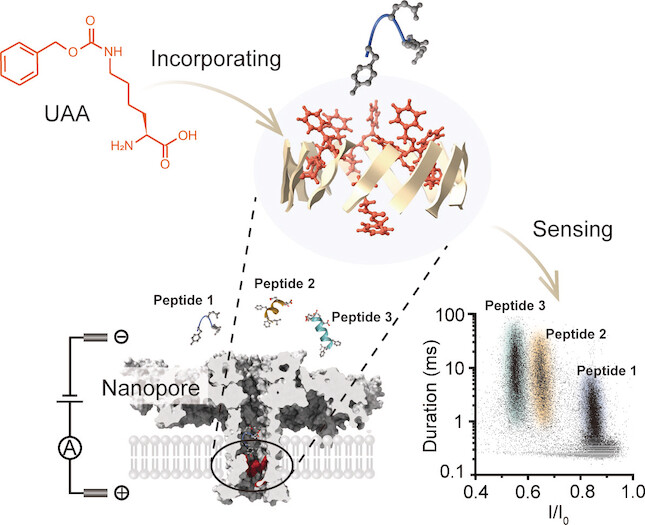
We present the application of the genetic code expansion technique to achieve the site-specific modification of the sensing region of a nanopore. The rationally designed conformation of unnatural amino acid (UAA) residues provides a favorable geometric orientation for the interactions of peptides and pore. The chemical environment of the sensing region facilitates the direct discrimination of the mixtures of peptides containing hydrophobic amino acids.
Sustainable Chemistry
Highly Selective Catalytic Oxi-upcycling of Polyethylene to Aliphatic Dicarboxylic Acid under a Mild Hydrogen-Free Process
- First Published: 21 May 2023
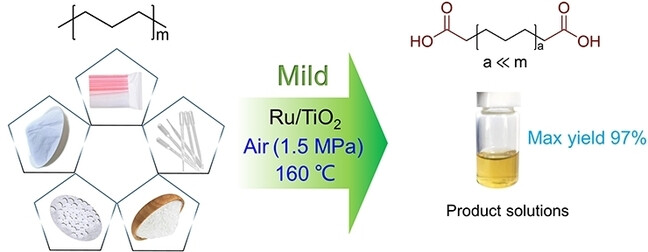
A low-temperature hydrogen-free process was developed for upcycling polyethylene into aliphatic dicarboxylic acid using a heterogeneous catalyst Ru/TiO2. The LDPE conversion can reach 95 % in 24 h under 1.5 MPa air at 160 °C with 85 % of the liquid product yield, which is mainly low-molecular-weight aliphatic dicarboxylic acid.
CO2 Reduction
Insights into Electrochemical CO2 Reduction on SnS2: Main Product Switch from Hydrogen to Formate by Pulsed Potential Electrolysis
- First Published: 23 May 2023

Introducing S-vacancies into SnS2 (Vs-SnS2) can significantly improve the electrocatalytic activity of CO2RR but leads to exclusive H2 evolution under static potential electrolysis. Pulsed potential electrolysis results in in situ generation of partially oxidized SnS2−x in the catalyst, which leads to a switch of the main product from hydrogen to formate during the CO2RR with the oxide phase selective to formate and the S-vacancy to H2.
Peptides
A Chemoenzymatic Approach To Produce a Cyclic Analogue of the Analgesic Drug MVIIA (Ziconotide)
- First Published: 06 May 2023
Nanoelectrochemistry
An Integrated Dual-Functional Nanotool Capable of Studying Single-Cell Epigenetics and Programmable Gene Regulation
- First Published: 15 May 2023
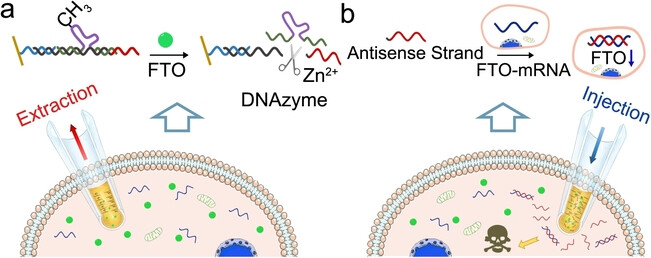
An integrated iontronic nanotool was developed for the study of single-cell epigenetics and programmable gene regulation. With the nanotool, an N6-methyladenine (m6A)-modified deoxyribozyme (DNAzyme) was used for profiling a representative m6 A-modifying enzyme, fat mass and obesity-associated protein (FTO), which also released a DNA sequence that could be programmed as an antisense strand against intracellular FTO-mRNA.
Natural Products
Asymmetric Total Synthesis of Cytotrienin A: Late-Stage Installation of C11 Side Chain onto the Macrolactam Scaffold
- First Published: 22 May 2023

Asymmetric total synthesis of cytotrienin A, an ansamycin antibiotic with apoptosis-inducing activity, is described. The strategic use of the redox properties of hydroquinone and the traceless Staudinger reaction enabled the late-stage installation of the C11 side chain, which plays a critical role in its biological activity, onto the macrolactam and opens new opportunities for the structure–activity relationship studies of ansamycin antibiotics.
Non-canonical Biosynthesis of the Brexane-Type Bishomosesquiterpene Chlororaphen through Two Consecutive Methylation Steps in Pseudomonas chlororaphis O6 and Variovorax boronicumulans PHE5-4
- First Published: 03 May 2023

In the biosynthetic pathway of the first natural brexane-type compound, chlororaphen, farnesyl pyrophosphate (FPP) is methylated and cyclized by a non-canonical FPP methyltransferase (FPP-MT), furnishing γ-presodorifen pyrophosphate (γ-PSPP). Methylation by the γ-PSPP-MT yields α-prechlororaphen pyrophosphate (α-PCPP), which is converted into the bishomosesquiterpene chlororaphen by the chlororaphen synthase (ChloS).
Dual Catalysis
Radical Coupling Initiated by Organophosphine Addition to Ynoates
- First Published: 15 May 2023

Combining established two electron nucleophilic catalysis of organophosphines with photoredox organocatalysis has allowed the discovery of a mechanistically unusual Giese coupling reaction. In addition to addressing a limitation in traditional photoredox coupling with electron-poor alkynes these studies demonstrate the viability of reaction designs that merge traditional nucleophilic phosphines organocatalysis and photoredox events.
Silver Nanoclusters
Disc-Like Silver Nanocluster Ag93 Built with Bicapped Hexagonal Prismatic Ag15 and Ino Decahedral Ag13 Units
- First Published: 21 May 2023
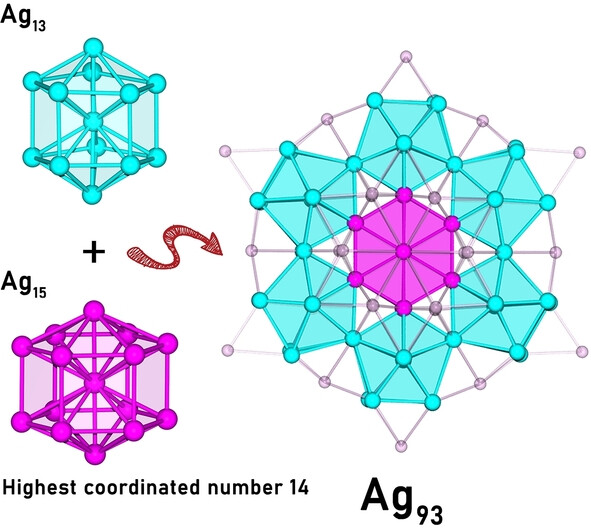
The largest structurally characterized cluster of clusters [Ag93(PPh3)6(C≡CR)50]3+ (R=4-CH3OC6H4) is prepared. It is a disc-shaped structure, its Ag69 kernel consists of a bicapped hexagonal prismatic Ag15 wrapped by six Ino decahedral Ag13 units through edge-sharing. The central silver atom has an unprecedented high coordination number of 14. This is the first time that Ino decahedra act as building blocks to assemble a supercluster.
Thin Films
Two-Dimensional LDH Film Templating for Controlled Preparation and Performance Enhancement of Polyamide Nanofiltration Membranes
- First Published: 12 May 2023
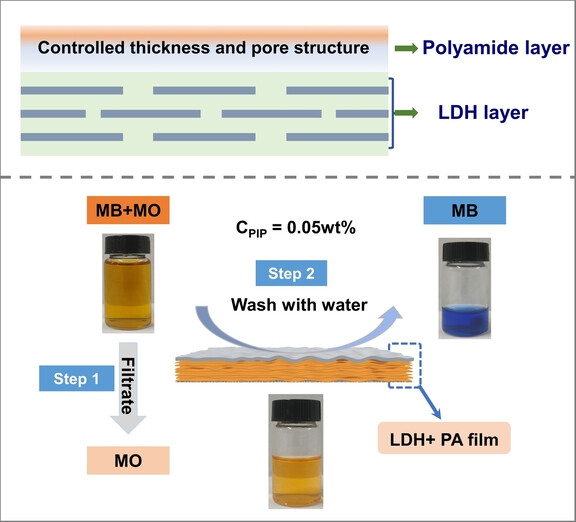
The layered double hydroxides (LDH) intermediate layer facilitates controlled interfacial polymerization between trimesoyl chloride and piperazine, which results in two membranes with good separation performances towards salts and dyes. Due to the low water transport resistance of the LDH layer and the thinner polyamide layer, the composite membrane has a larger flux, which is a breakthrough in the trade-off between permeance and selectivity.
Redox Chemistry | Hot Paper
Phosphine Oxide-Functionalized Terthiophene Redox Systems
- First Published: 16 May 2023

Although main group redox systems are attractive as next-generation energy storage media, achieving high cell voltages via extreme redox couples typically compromises their long-term stabilities. We show that phosphine oxide functionalization can render terthiophenes robust two-electron acceptors at very low potentials, thus opening fundamentally new parameter space in the search for stable main group redox systems with high cell voltages.
Biosynthesis | Very Important Paper
Structure-Function Analysis of the S-Glycosylation Reaction in the Biosynthesis of Lincosamide Antibiotics
- First Published: 24 May 2023

The S-glycosyltransferase LmbT is the only known enzyme that catalyzes the incorporation of ergothioneine, 1, into secondary metabolites. The structure and function analysis of LmbT provided a structural basis for the SN2-like S-glycosylation reaction with ergothioneine. These findings will lead to the mechanistic understanding of key enzyme reactions in the biosynthesis of ergothioneine-containing natural products such as lincomycin A.
Carrier Protein Mediated Formation of the Dihydropyridazinone Ring in Actinopyridazinone Biosynthesis
- First Published: 17 May 2023

Actinopyridazinone biosynthesis represents a unique biochemical transformation of an amino acid. It involves Nγ-amination of DABA using alanine as a nitrogen donor. An acetyl hydrazone intermediate undergoes an unprecedented carrier protein mediated heterocyclization to give a dihydropyridazinone. This is a sophisticated biosynthetic strategy in which an acetylation temporarily protects the reactive hydrazone during biosynthesis.
Asymmetric Catalysis | Hot Paper
Enantioselective Synthesis of 1,2-Benzothiazine 1-Imines via RuII/Chiral Carboxylic Acid-Catalyzed C−H Alkylation/Cyclization
- First Published: 17 May 2023

Enantioselective C−H alkylation/cyclization of sulfondiimines with sulfoxonium ylides using a RuII catalyst and a newly developed chiral spiro carboxylic acid enables the synthesis of 1,2-benzothiazine 1-imines, thus expanding the accessible chemical space of chiral hexavalent organosulfur scaffolds relevant to biologically active compounds.
Natural Products
Total Synthesis of Sculponin U through a Photoinduced Radical Cascade Cyclization
- First Published: 18 May 2023
Bioanalytical Chemistry
Profiling Phosphoproteome Landscape in Circulating Extracellular Vesicles from Microliters of Biofluids through Functionally Tunable Paramagnetic Separation
- First Published: 22 May 2023

Extracellular vesicle to phosphoproteins (EVTOP) as a novel strategy achieves one-pot EV isolation, extraction and digestion of EV proteins, and enrichment of phosphopeptides starting with microliters of biofluids, enabling ultrasensitive EV phosphoproteome analyses of challenging biofluids such as plasma and cerebrospinal fluid with limited volume.
Photochemistry | Hot Paper
Amine-Free, Directing-Group-Free and Redox-Neutral α-Alkylation of Saturated Cyclic Ketones
- First Published: 23 May 2023

As a powerful complement to existing organic amine catalysis, direct activation of the α-C−H bonds of saturated cyclic ketones is realized for the first time in an amine-free and directing-group-free catalytic mode. The carbonyl group binds to a defect site of the quantum dot (QD) surface, selectively weakening the α-C−H bond, instead of the β-C−H bond, and exclusively generating an α-C radical under visible-light irradiation. This unique activation platform leads to selective activation of the α-C−H bonds of cyclic ketones under redox-neutral conditions.
Self-Assembly
Surface-Area Determination of Anisotropic Polymersomes by Amphiphilic Molecular Probe Loading
- First Published: 22 May 2023

A molecular probe loading method is developed to measure the surface area of anisotropic polymersomes in the shape of tube, disc, and stomatocyte. This method relies on the loading of an amphiphilic molecular probe onto the PEG corona of polymersomes as a monolayer. The surface area of anisotropic polymersomes is determined by the loading amount of probes.
Silver Clusters
Elucidating the Structures of Intermediate Fragments during Stepwise Dissociation of Monolayer-Protected Silver Clusters
- First Published: 22 May 2023
MOF Glasses | Very Important Paper
Multi-stage Transformations of a Cluster-Based Metal-Organic Framework: Perturbing Crystals to Glass-Forming Liquids that Re-Crystallize at High Temperature
- First Published: 07 May 2023
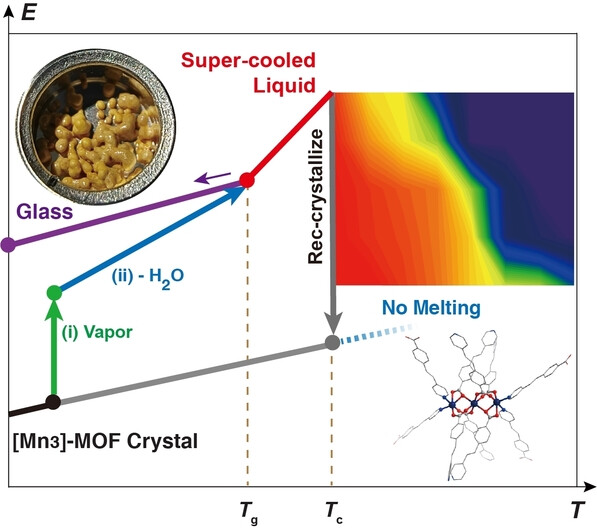
The first MOF glass composed of metal-carboxylate cluster building units is vitrified by multi-stage transformations: The crystalline MOF is amorphized by vapor hydration and thermal dehydration, goes through a glass transition to enter a super-cooled liquid state, and recrystallizes into the initial structure. These multi-stage transformations are a rare example of high-temperature coordinative recognition and self-assembly.
Perovskite Ferroelectrics | Hot Paper
Hybrid Improper Ferroelectricity in Columnar (NaY)MnMnTi4O12
- First Published: 18 May 2023

In columnar order quadrupole perovskites A2A′A′′B4O12 hybrid improper ferroelectricity emerges through A-site cation ordering across anti-displaced structural columns. This novel form of polar order couples to an intrinsic proper ferroelectric instability associated with underbonded magnetic A′ Mn2+ ions, giving rise to a biased, asymmetric switching response under applied electric field that coexists at low temperature with antiferromagnetism.
MOFs
Assembling a Heterobimetallic Actinide Metal-Organic Framework by a Reaction-Induced Preorganization Strategy
- First Published: 21 May 2023
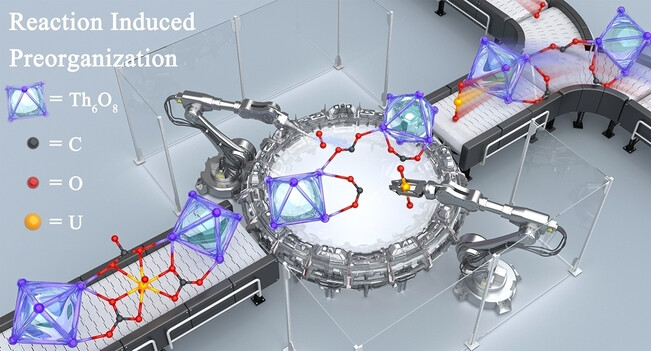
Benefiting from the unique architecture of the largest-unit-cell thorium metal–organic framework (MOF), a second actinide, uranyl, with dintinct coordination behaviour was successfully assembled into the framework via a novel reaction-induced preorganization strategy to yield a rare single crystalline heterobimetallic actinide MOF.
Polymers
Mucin-Inspired Single-Chain Polymer (MIP) Fibers as Potent SARS-CoV-2 Inhibitors
- First Published: 02 May 2023
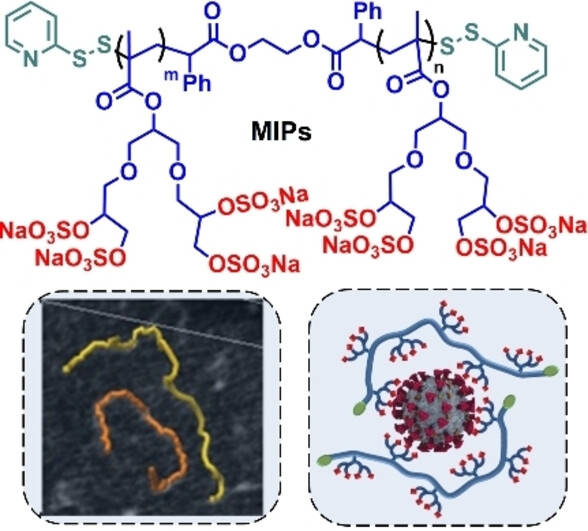
Inspired by biological mucus, here, we report multi gram-scale synthesis of dendronized polysulfates as mucin-inspired virus-binding polymer (MIPs). Cryo-electron tomography (Cryo-ET) analysis reveals their single chain fiber morphology. These biocompatible synthesized fibers inhibit SARS-CoV-2 infection and inhibitory activities depend on the length of the fibers.
Stereoselectivity
Discrimination of the Enantiotopic Faces of Structurally Unbiased Carbenium Ions Employing a Cyclohexadiene-Based Chiral Hydride Source
- First Published: 09 May 2023




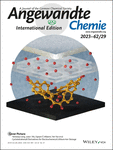
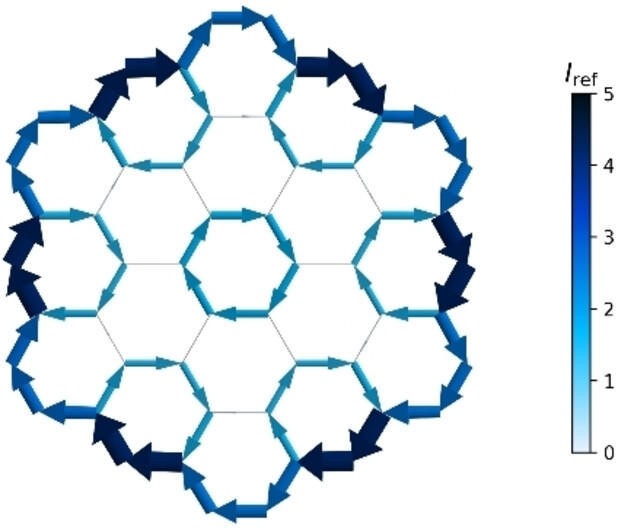
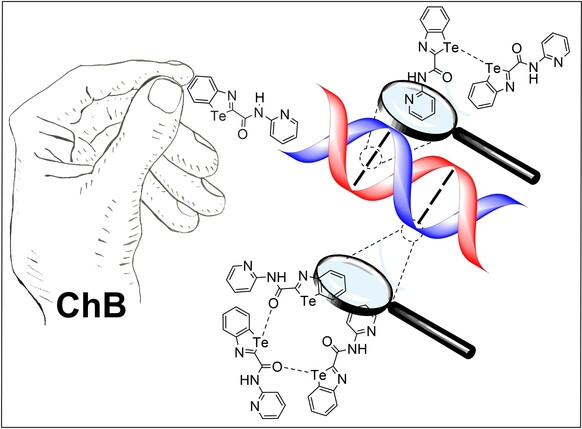
![Dynamic Axial-to-Helical Communication Mechanism in Poly[(allenylethynylenephenylene)acetylene]s under External Stimuli](/cms/asset/0a5f7208-6f3a-4927-ae2d-271835055a66/anie202303329-toc-0001-m.jpg)
